Karen Lynn Allen's Blog, page 6
November 26, 2013
The Brilliance of Walking
 "Walking in the Hills" Edward PotthastWalking. So simple. So powerful. So cheap. If you could put the benefits of walking 30 minutes a day into a pill, you'd drive 80% of all medications off the market and make untold billions. That's how great walking is. And you can get this wonder drug for free. Here are fifteen reasons to get out and walk:
"Walking in the Hills" Edward PotthastWalking. So simple. So powerful. So cheap. If you could put the benefits of walking 30 minutes a day into a pill, you'd drive 80% of all medications off the market and make untold billions. That's how great walking is. And you can get this wonder drug for free. Here are fifteen reasons to get out and walk:1) Weight loss. People who start walking 30 minutes a day at an easy pace of 3 mph lose an average of a pound a month. Running, walking faster, or walking longer will help you lose weight more quickly, but in any event, the pounds you lose by walking even 30 minutes each day are pounds that you'll keep off. Even if you're genetically predisposed to obesity, walking works. Currently one third of US adults are obese; another third are overweight. You don't have to be thin to be healthy, but there is no way to be sedentary and healthy.
 "Painter on His Way to Work" Vincent van Gogh2) Cancer Prevention. One third of cancer-related deaths are due to obesity and a sedentary lifestyle. Walking 30 minutes a day cuts risk of uterine and breast cancer in half for women. It cuts risk of colon cancer for both sexes by 60%. Even more extraordinary, walking can stop prostate cancer in its tracks. Men diagnosed with prostate cancer who start walking briskly 30 minutes a day are 57% less likely to see the disease progress. This is amazing. And for women with breast cancer with hormone-responsive tumors, those who walked an average of 30 minutes a day reduced risk of dying from their cancer by 50%.
"Painter on His Way to Work" Vincent van Gogh2) Cancer Prevention. One third of cancer-related deaths are due to obesity and a sedentary lifestyle. Walking 30 minutes a day cuts risk of uterine and breast cancer in half for women. It cuts risk of colon cancer for both sexes by 60%. Even more extraordinary, walking can stop prostate cancer in its tracks. Men diagnosed with prostate cancer who start walking briskly 30 minutes a day are 57% less likely to see the disease progress. This is amazing. And for women with breast cancer with hormone-responsive tumors, those who walked an average of 30 minutes a day reduced risk of dying from their cancer by 50%.3) Prevents heart disease. Reduces risk by 40%. Heart disease is the leading cause of death in the US for both men and women.
4) Reduces incidence of high blood pressure by 40%.
5) Lowers the risk of stroke by 37%.
 "Tobias and the Angel" Piero del Pollaiolo6) Boosts the immune system to fight off colds and flus. And if you do get sick, being fit reduces the number of days you are sick, the number of symptoms you experience, and the overall severity of the illness by 30%. Being fit via moderate exercise is proven to reduce the number of sick days you'll take better than any pill or nutritional supplement.
"Tobias and the Angel" Piero del Pollaiolo6) Boosts the immune system to fight off colds and flus. And if you do get sick, being fit reduces the number of days you are sick, the number of symptoms you experience, and the overall severity of the illness by 30%. Being fit via moderate exercise is proven to reduce the number of sick days you'll take better than any pill or nutritional supplement.7) Cuts likelihood of getting type 2 diabetes in half.
8) Good for the heart and circulatory system. Keeps arteries and veins unclogged and functional.
9) Reduces bad cholesterol, regulates blood sugar levels, and aids digestion. (Especially good if done 15 minutes after a meal.)
10) Prevents depression. Reduces depression as well or better than, Zoloft, Prozac or behavioral therapy. This is true no matter your age. Currently in the US, of my age cohort--women between 50 and 65--a full one fourth are taking antidepressants. This is nuts. Walking also alleviates stress and anxiety and helps you fall asleep at night and stay asleep.
11) Combats arthritis and strengthens joints. Eases lower back pain as effectively as a muscle-strengthening program at a clinic. Reduces need for pain medication.
12) Strengthens your bones. Reduces risk of osteoporosis.
13) Helps pregnant women with a host of common pregnancy problems including back pain, constipation, swelling and trouble sleeping. Walking during pregnancy (and during first part of labor) is also proven to result in shorter labors, reduces the risk of gestational diabetes and miscarriage, and makes it easier to get back to your normal weight after the baby is born.
 "Couple Walking with Crescent Moon" Vincent Van Gogh14) Keeps your brain functioning in old age. Reduces risk of Alzheimer's by 50%. Reduces brain atrophy, dementia and cognitive decline. Reduces likelihood of brain shrinkage.
"Couple Walking with Crescent Moon" Vincent Van Gogh14) Keeps your brain functioning in old age. Reduces risk of Alzheimer's by 50%. Reduces brain atrophy, dementia and cognitive decline. Reduces likelihood of brain shrinkage.15) Improves health and well-being later in life. Being fit in your fifties compresses the likelihood of experiencing chronic, debilitating illness into the last five years of life rather than the last 10, 15 or even 20 years of life that occurs for sedentary people.
Of course walking is not the only form of moderate physical exercise that's good for you. Bicycling, swimming, ballroom dancing, yoga, and tai chi are also options, and no doubt there are dozens of others as well. Whatever exercise you choose, you don't have to get out of breath and sweaty to benefit. But you do need to do something that gets you moving and your blood circulating for thirty minutes almost every day. It doesn't have to be all at one time, but just puttering around your house or the office doesn't count.
Why is walking or other moderate exercise so crucial for human health? Part of the answer lies in our lymphatic system. This is the system our bodies rely on to carry nutrients to our cells and cart off all the routine wastes of cellular function, wastes that become toxic if allowed to build up. The lymphatic system also produces and transports white blood cells and disease-fighting antibodies. But this system doesn't have its own pump like the blood system does. It relies on muscular movement to pump lymph fluid around the body. A sluggish lymph system inevitably means a sluggish immune response to disease or infection and can contribute to many other health problems, from swelling to headaches to sinus issues. Without your body's movement the lymph can't circulate and can't do its job protecting your health.
The very best way to get moderate exercise regularly is to work it into your daily routine. Can you walk to work? Can you park a mile away from work and walk the last bit? Can you walk at lunchtime? Is there a store or business you frequent regularly that is walking distance from home? Is there a pleasant place in your neighborhood you can take a walk after dinner?
I hope I've convinced you walking is better than any drug you could take. More tips on getting started:1.) Baby steps. Set small goals at first--even 5 minutes of walking a day is good! Increase by 2 minutes each day. By the end of two weeks you'll be up to 30.2.) Get a walking buddy, someone you can meet to get you out and walking.3.) Get a pair of shoes comfortable for walking so that lack of footwear does not get in your way. (Even a $30 pair of athletic shoes will do.)4.) Listen to music, though only have an earbud in one ear if walking near car traffic.5.) Give yourself a non-food reward for walking every day for a week, for two weeks, for a month. Post your progress on Facebook, or even make a chart with stars on your refrigerator. 6.) If you can, get your exercise in nature. This has proven spirit-lifting benefits even beyond walking.
In my first novel, Pearl City Control Theory, I wrote about city Buddha-mind walking and its emotional and philosophical benefits with little idea of walking's health impact. But I wrote Pearl City way back in 1992, and it was published in 1999, well before the abundance of studies and scientific analyses about walking that appeared this past decade. The reasons to walk are even more pressing now than they were in 1992.
Starting a habit of walking is initially going to take energy and willpower. Be dogged, be determined. After a month, you'll have noticeably more energy, endurance and stamina. You will be stronger. You will see things you've never noticed before. You will get sick less often, your spirits will lift, and you will just feel a heck of a lot better. Happy Rambles!
Published on November 26, 2013 17:55
September 27, 2013
Some States Are Adding Wind and Solar Capacity Like Crazy! Is Yours?
Some States Are Adding Wind and Solar Capacity Like Crazy! Is Yours?
[image error]
Some very heartening data has come out of the U.S. Energy Information Administration (EIA) in their recently released July 2013 year-to-date numbers on electricity generation by state. Some surprising states are adding wind and solar capacity at an amazing clip: Iowa! Kansas! Oklahoma! Arizona! Nevada! North Carolina! New Jersey! Vermont! Other states are doing little or nothing even when they have excellent wind and sun potential falling in their laps.
Before we examine each state, let’s consider solar and wind potential on a national level. One U.S. news broadcaster of note reported that Germany has installed 15 times the per capita solar generating capacity of the US because Germany is sunnier than the U.S. Ho, ho, ho! One tiny little internet search will show you that Germany gets less direct energy from the sun than any U.S. state except, possibly, Alaska. Which means every U.S. state except Alaska has decent solar potential. In fact, many US states get far more solar insolation than sunny Spain!
[image error] Germany is the cold-looking one on the right.As you can see, our southwest states have very, very high solar potential. This means every solar panel in these places would generate double the electricity that the same panel placed in Germany would. Some of these extremely sunny states are taking advantage of this fact. Some are not.
Onto wind. Here is a map of wind potential and installed wind capacity cumulative to 2012. As you can see, the whole Midwest from North Dakota down to Texas is smoking hot. Absolutely amazing wind potential. And yet some states are taking advantage of this and some are not.
[image error] The bluer the windier
Onto the states!
We’ll examine them by census district since that is how the US EIA divides them up. The EIA numbers only include solar energy produced by utilities and Independent Power Producers (IPPs). We have to look separately to find residential solar installations. In the EIA’s national numbers, the electricity produced by residential solar largely shows up not as production but as reduced demand. Note: generally when I refer to renewables, I mean “all renewables except large hydro” and I will spell out large hydro separately. Also note: in general I’m not a huge fan of nuclear power and would rather not see new nuclear plants built. But in my opinion unless one is in a dangerous area or is falling apart, keeping it going constitutes less of a threat than continuing to burn coal.
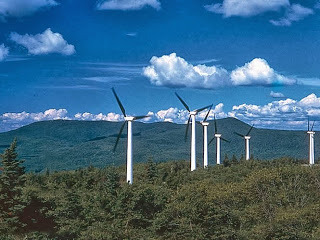 New England: So far in 2013 Maine has increased its installed wind capacity by 12% over 2012, with wind now providing 7% of the electricity it generates. Maine has installed almost no solar. Since Maine exports electricity, if we consider just internal consumption, hydro renewables covers 72% of Maine’s electricity demand. New Hampshire expanded wind generation last year by 38 %, but the total still comes to a very small amount. If they stopped burning fossil fuels tomorrow, their internal consumption could be supplied by hydro renewables nuclear with still 30% left over to sell to other states. Vermont nearly tripled its wind capacity over last year, but the amount is still pretty tiny. However, hydro all renewables makes up 40% of the electricity it consumes internally. The state has installed a significant amount of residential solar, making it ninth in the nation for solar capacity per person. Vermont has at least as much wind potential as Maine yet has one fourth the installed wind capacity.
New England: So far in 2013 Maine has increased its installed wind capacity by 12% over 2012, with wind now providing 7% of the electricity it generates. Maine has installed almost no solar. Since Maine exports electricity, if we consider just internal consumption, hydro renewables covers 72% of Maine’s electricity demand. New Hampshire expanded wind generation last year by 38 %, but the total still comes to a very small amount. If they stopped burning fossil fuels tomorrow, their internal consumption could be supplied by hydro renewables nuclear with still 30% left over to sell to other states. Vermont nearly tripled its wind capacity over last year, but the amount is still pretty tiny. However, hydro all renewables makes up 40% of the electricity it consumes internally. The state has installed a significant amount of residential solar, making it ninth in the nation for solar capacity per person. Vermont has at least as much wind potential as Maine yet has one fourth the installed wind capacity. [image error] This data is from 2012.Massachusettsimports 61% of the electricity it consumes, sucking up all the excess electricity from the surrounding states and then some. So far in 2013 it has doubled its wind capacity over 2012 and almost quadrupled its solar output from utility/IPPS. Unfortunately, that’s not saying much since both are still tiny. It has, however, installed a significant amount of residential solar, making it 10thin the nation in installed solar per capita. In fact, in the second quarter of 2013, it was fifth in the nation for total solar installations.
Connecticutproduces about half the electricity it generates from nuclear, almost none from wind or solar, and is a sizable energy exporter. If the state stopped burning fossil fuels tomorrow, it could cover 66% of its own electricity needs with nuclear hydro renewables. Rhode Island produces almost no electricity from wind or solar. It imports a fifth of its electricity and produces pretty much all the rest from fossil fuels. (Sigh.) It can certainly do better.
[image error] Middle Atlantic: Though New Jersey has next to no wind capacity installed, it has gone whole hog with residential solar! It has the third highest installed solar capacity of all US states, and 2nd quarter of 2013 it was also third for newly installed capacity. New Jersey imports 14% of its electricity, generates 45% through nuclear power, and has over half its electricity coming from fossil fuels. New York increased its wind capacity by 14% over last year but has done very little in the way of solar. Though it has good wind potential in the western part of the state, it produces about as much electricity from wind as Pennsylvania, a state with far less potential. New York imports a small percent of its electricity, gets 22% from hydro renewables and 31% from nuclear. With its large population, New York is a high electricity-consuming state.Pennsylvania is a huge energy producer, generating more electricity than any other state except Texas. It exports 37% of its electricity, a fifth or so going to New Jersey and New York, and the rest likely going south. Pennsylvania ramped up its wind capacity by 50% this year over last. Still, wind makes up just 1.5% of the total electricity it produces. Pennsylvania is a huge nuclear state, second only to Illinois in the amount of nuclear energy it produces. And it burns a heck of a lot of fossil fuels (mostly coal.) If Pennsylvania didn’t export electricity, it could cut its fossil fuel consumption by two thirds.
[image error] Wind in 2000--pretty sparseEast North Central:Illinois is cantering ahead of this pack in terms of installed wind. It increased its wind generation by 25% over last year, and wind now makes up 5% of its total electric generation. This is substantial progress given much electricity this state generates. It also has a small amount of solar. Illinois exports 30% of the electricity it generates. If it didn’t export electricity it could cover 75% of its electricity demand with renewables hydro nuclear. Indianahas very good wind potential but it increased wind production by just 10% last year. Renewables make up less than 4% of its energy production. They have no nuclear, negligible hydro and solar, and are a small electricity exporter. Michigan doubled its wind capacity last year, but they are playing catch up even with Indiana. Michigan is self-sufficient in electricity generation with 27% coming from nuclear and 4% from renewables hydro.
Ohio imports 10% of its electricity, gets very little from wind or solar and 10% from nuclear. I’m depressed just thinking about it. Wisconsinhas wind installed at a level comparable to Michigan—a little over 2% of their net electricity generation. They import a small amount of electricity.
[image error] Wind in 2012--getting gustyWest North Central: This is the area of the country where things are really interesting! Iowa has been installing wind capacity like crazy, and it now generates a full 28% of its electricity from wind. But Iowa is also an electricity exporter. If we only consider the energy Iowa consumes, 35% is generated from wind! This is a great accomplishment. Kansas is also going pedal to the metal on wind. It doubled its installed wind capacity over last year, and is now producing 20% of its electricity via wind. It is also an electricity exporter, so if we just consider its electrical demand alone, 25% is covered by wind. Minnesota ramped up their wind capacity a bit and is now up to 16% of its electricity generated by wind. However, Minnesota imports a full quarter of its electricity, which, right now, means other states burn fossil fuels to make electricity to export to it.
South Dakota and North Dakota come third and fifth in the region’s wind production derby, producing 28% and 15.5% of each state’s electricity via wind. Strangely enough, with all the great wind blowing through their states both North Dakota and South Dakota added no new wind generation capacity this year over last. If North Dakota had as much wind capacity installed as Iowa, and South Dakota as much as Oklahoma, both would have their electricity needs covered entirely.
And then there are Nebraskaand Missouri, pulling up the rear of the group. Now Missouri has decent, though not exceptional, wind and solar potential. (Better than New Jersey! Better than Germany!) However, it is moving forward on neither and burns large amounts of fossil fuels in order to be an energy exporter. Nebraska, on the other hand, has fabulous wind potential, just as good as Kansas and probably better than Iowa. (It also has pretty darn good solar potential.) And yet they’ve only installed one-fifth the wind capacity of Kansas, and one-tenth the wind capacity of Iowa. Why is all this beautiful, productive, cheap wind going to waste? Someone is asleep at the switch.
South Atlantic: This is a region of the country that imports a lot of electricity. The only states that don’t are West Virginia, Florida and South Carolina. Except for little pockets of the Appalachia’s, these states don’t have great on shore wind potential, though offshore is a possibility for most. All, however, have good to very good solar potential. West Virginia has the best wind, and it’s installed a small amount of capacity but could have much more. It exports more energy than it consumes by burning coal. Sunny Florida is number 10 in the US in terms of total installed solar but seems to have flat-lined with little capacity being added. It wasn’t in the top ten states for solar installed in the 2nd quarter of 2013. Though Florida consumes more electricity than any state besides Texas and California, only 2% of its electricity comes from renewables.
[image error] North Carolina is doing the best on solar in this sunny region, increasing its utility/IPP produced solar electricity by a factor of six in the last year! They were fourth in the nation in solar capacity installed in Q2 of 2013, and fifth in the nation for total cumulative capacity installed. Adjacent South Carolina, in contrast, has had almost no solar installation activity. Nor has Georgia, even though that state has solar potential Ohio would give its right arm for. Maryland has added a teeny bit of wind but you would think they would want to do more since they are a large electricity importer. The District of Columbia produces almost no electricity of any kind, relying nearly entirely on imports.
Interestingly, per capita, Delaware has the 7th highest solar PV capacity installed of any state (mostly residential), but they are such a small state with so little population, it hardly shows up on the radar. Delaware imports roughly a third of its electricity. Virginiaalso imports nearly a third of its electricity, and since they are a much bigger state, this adds up to a rather massive amount. Surprisingly, they’ve installed little wind or solar to speak of.
[image error] East South Central—Alabama, Kentucky, Mississippi, TennesseeBasically a black hole for solar and wind. And yet all four have good to very good solar potential and all but Alabama have some wind potential where their states border the Mississippi river. All the states but Tennessee are electricity exporters; Tennessee is a very large importer.
 (Photo: texastribune.org)West South Central: Arkansasand Louisiana are two more black holes for solar and wind, both nuclear states, both net energy exporters, both burning lots of fossil fuels. Both have excellent solar potential and even a little wind potential. Texas and Oklahoma are a different story. Texas has the most wind capacity installed of any state in the nation. However, because it produces more electricity than any state in the nation, wind comes to only 9% of all electricity produced. But this year alone Texas has increased wind capacity 18% over last year, and they increased their--admittedly limited amount--of solar capacity by 25%. Texas exports a huge amount of electricity, second only to Pennsylvania. They have excellent solar potential, especially in the western half of the state. Oklahoma is playing catch up to Texas, increasing its wind capacity by 38% in one year! They are producing 13% of their electricity via wind, and 20% of the electricity they actually consume. (They are exporters as well.) Not much solar to speak of, although they, too, have excellent potential.
(Photo: texastribune.org)West South Central: Arkansasand Louisiana are two more black holes for solar and wind, both nuclear states, both net energy exporters, both burning lots of fossil fuels. Both have excellent solar potential and even a little wind potential. Texas and Oklahoma are a different story. Texas has the most wind capacity installed of any state in the nation. However, because it produces more electricity than any state in the nation, wind comes to only 9% of all electricity produced. But this year alone Texas has increased wind capacity 18% over last year, and they increased their--admittedly limited amount--of solar capacity by 25%. Texas exports a huge amount of electricity, second only to Pennsylvania. They have excellent solar potential, especially in the western half of the state. Oklahoma is playing catch up to Texas, increasing its wind capacity by 38% in one year! They are producing 13% of their electricity via wind, and 20% of the electricity they actually consume. (They are exporters as well.) Not much solar to speak of, although they, too, have excellent potential.[image error] Feel the desert rays (photo: energy.gov)Mountain: These are states that have good to totally astonishing solar potential. Most have good to extremely good wind potential. Arizona is doing the best with solar, as it should because it is one of the best places on the planet for it. Arizona more than doubled its installed solar capacity last year and is second for utility/IPP generated solar only behind California. It also nearly doubled its wind capacity last year. Even after all this, renewables still only make up 2% of its electricity generation. However, it is a big nuclear state and a big electricity exporter. Renewables hydro nuclear could cover 56% of its internal electricity consumption if the state stopped burning fossil fuels tomorrow. Nevada increased its utility/IPP solar generation of electricity by 68%, and its wind generation by ten fold! Renewables make up 11% of the electricity it consumes, and hydro renewables makes up 19%. Nevada is fourth in the nation for total solar capacity installed (including residential) and second when considered per capita.
New Mexico eked out small increases in both solar and wind, and is now up to nearly 8% of their electricity generated coming from the two together. They are an energy exporter. Colorado and Idaho both made great strides with wind capacity this year, increasing by 15% and 43% respectively. Wind solar makes up 14% of Colorado’s consumption, and 13% of Idaho’s. Throw in hydro and you get 18% for Colorado and 59% for Idaho! Idaho imports almost a third of its electricity. Colorado generates close to as much electricity as it consumes.
Montana and Wyoming are two more wind-rich states with good solar potential. Montana increased wind capacity by 27% while Wyoming increased not at all. Neither state has much solar installed. Montana has a lot of hydro which allows hydro renewables to supply 94% of its internal consumption. However, Montana still burns fossil fuels to make electricity to export to other states. Wyoming, being the preeminent coal state of the US, burns massive amounts of coal and exports that electricity to other states, including California. Wyoming also uses massive amounts of energy for their mining industry. If their mining industry ended tomorrow, their internal electricity needs would be covered by renewables hydro, and they would have electricity left over to export.
Utah could and should be a very good wind and a great solar state. It is neither.
[image error] A day in California (Fun website to check out!)Pacific Contiguous: Californiacontinues its lead in solar and is working hard to pass Iowa to regain second place in the wind derby. It more than doubled its utility/IPP solar capacity and increased its wind by 42% over last year. This is on top of already having the third wind largest installation in the US. It also produces quite a bit of electricity by way of geothermal and biomass, so its renewables produce 20% of the electricity it generates. California is very energy efficient and has one of the lowest per person consumption of electricity in the US. However, California is a big, big state with many people, and over the past decades it did not increase its electric generation in proportion to its growing population. This has turned California into the nation’s greatest importer of electricity, snarfing up pretty much all the excess electricity that might be lurking in any of the western-most states. 23% of California’s electricity currently comes from out of state. Some of this is hydro from the Pacific Northwest, but much of it is electricity from coal burnt by our more easterly neighbors. Still, the installation of sun and wind capacity go on, and just last week, in a 24 hr period on an average day in September, California produced 22% of the electricity it consumed via renewables. (solar thermal solar PV wind small hydro geothermal biogas biomass) I will guess by next summer California will be up to 25% via renewables.
Oregon and Washington have very good wind potential and they are both ramping up wind capacity, though Oregon more so than Washington. Oregon increased wind generation over last year by 24%, pulling ahead of Washington who increased by only 3%. Renewables in Oregon make up 20% of electricity consumption, whereas in Washington they make up only 10%. But both states have lots of hydroelectric, and both export electricity (mostly to California.) If we just consider these states internal consumption, renewables hydroelectric make up 99% of Oregon’s electricity and 103% of Washington’s.
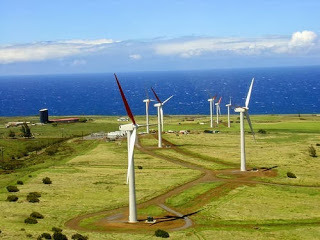 Tropical wind (photo: beyondhonolulu.com)Pacific Noncontinguous: Alaska and Hawaii are their own special cases with difficulty importing or exporting electricity to/from other states. I’m pretty sure both within a decade will be reliant entirely on renewables for electricity, and the quicker they do it, the better off they will be. Alaska has very good to excellent wind potential but minimal wind capacity installed. Solar is tough for them, but it might get to the point that solar in summer alone is worth it. Alaska has a certain amount of hydroelectric and a small population, so hydro renewables right now makes up 23% of their electricity consumption. If they were to build out their wind capacity merely to the extent Indiana or Wyoming has, they would be self-sufficient in electricity (though they would probably need some pumped hydro storage.) Hawaii has excellent solar potential and very good wind. It increased its wind capacity by 25% this last year but it’s still very small—only 5% of what they consume. They have no utility/IPP solar at all, though they have quite a bit of residential solar and are third in the nation for per capita solar capacity installed. If they built out their wind to the level of Oklahoma and their utility/IPP solar to that of Nevada, they would be in very good shape, though they would perhaps need to have some pumped hydro storage as well.
Tropical wind (photo: beyondhonolulu.com)Pacific Noncontinguous: Alaska and Hawaii are their own special cases with difficulty importing or exporting electricity to/from other states. I’m pretty sure both within a decade will be reliant entirely on renewables for electricity, and the quicker they do it, the better off they will be. Alaska has very good to excellent wind potential but minimal wind capacity installed. Solar is tough for them, but it might get to the point that solar in summer alone is worth it. Alaska has a certain amount of hydroelectric and a small population, so hydro renewables right now makes up 23% of their electricity consumption. If they were to build out their wind capacity merely to the extent Indiana or Wyoming has, they would be self-sufficient in electricity (though they would probably need some pumped hydro storage.) Hawaii has excellent solar potential and very good wind. It increased its wind capacity by 25% this last year but it’s still very small—only 5% of what they consume. They have no utility/IPP solar at all, though they have quite a bit of residential solar and are third in the nation for per capita solar capacity installed. If they built out their wind to the level of Oklahoma and their utility/IPP solar to that of Nevada, they would be in very good shape, though they would perhaps need to have some pumped hydro storage as well. So that concludes our tour solar and wind in the United States. Some states are leaping ahead; some are sitting on their hands. Who will be better off in ten year’s time? In the last year, the US has gone from 5.5% of its electricity generated from renewables to 6.4%, a much greater increase than ever before. I’m guessing we’ll be up to nearly 8% by next summer. Especially if Nebraska and South Dakota wake up and smell the kilowatts.
Published on September 27, 2013 19:41
May 5, 2013
Why Everyone Who Loves San Francisco Should Clamor for Polk Street Bike Lanes
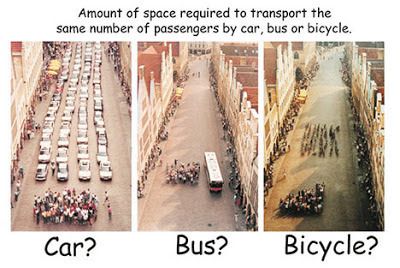
It’s the space. Nearly half of San Francisco’s population lives in a quarter of the land, the northeast quadrant of the city. Between now and the end of 2015, San Francisco is likely to gain another 30,000 people, most of them to this sector. This area is already one of the densest in North America, parts of it second only to Manhattan. And it already holds 42% of all San Francisco’s cars (150,000!) If these new people own cars similar to the rates of current residents, they will bring 12,000 additional cars into this quadrant. Even if all these cars have off street parking, how will congested NE streets have room for 24,000 – 36,000 extra car trips each day? Congestion isn’t linear. 8% more cars doesn’t make already congested traffic 8% worse. It makes it impossible. More people in the same square footage means we need fewer cars and less driving. It means we need to encourage people to go car-lite or car-free.
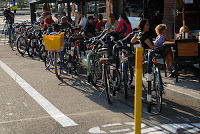 12 shoppers or one?Cars take up a lot of room. Parked curbside, a private car requires 200 square feet; in a garage 300 feet. The average car is parked 95% of the time. When actually in motion, the space that just two cars take up can fit twenty people on bikes or 30 people on a bus. When not in use, twelve bikes can park in the space of one car. Parked or moving, cars are a highly inefficient use of public real estate. In the middle of Nebraska this is perhaps not an issue. In San Francisco it is.
12 shoppers or one?Cars take up a lot of room. Parked curbside, a private car requires 200 square feet; in a garage 300 feet. The average car is parked 95% of the time. When actually in motion, the space that just two cars take up can fit twenty people on bikes or 30 people on a bus. When not in use, twelve bikes can park in the space of one car. Parked or moving, cars are a highly inefficient use of public real estate. In the middle of Nebraska this is perhaps not an issue. In San Francisco it is. A modest 8% reduction in parking in the Polk Street area will affect few people. Already 85% of people come to Polk Street by modes other than car. Maybe this is because two-thirds of households in the neighborhoods adjoining Polk don’t own cars. (ACS data 2009.) Maybe this is because all of Polk Street is on or within a block of a bus line. Maybe this is because half of Polk is within a 15 minute walk of BART. Maybe this is because Polk Street is the geographic center of the NE quadrant, which means potentially half the population of the city can bike to Polk Street within 20 minutes.
It’s the topography.
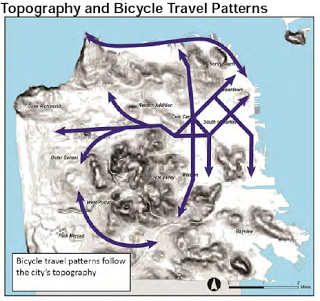 Hilly SF (source: SFMTA)San Francisco has hills. Main arterials and shopping neighborhoods are found in the flat parts between them for a reason. Currently there are no bike lanes that extend from Market to the north part of town between the Embarcadero and Arguello. This means there is no safe way for bicyclists to reach a huge chunk of the city. Gnarly hills mean Polk Street is the only north/south route for bicyclists to take for a mile in either direction. (Van Ness is flatter but it’s not an option because it’s part of US 101.) This is why Polk is already the street with the highest rate of biking north of Market between the Embarcadero and the Wiggle. This is why Polk matters so much.
Hilly SF (source: SFMTA)San Francisco has hills. Main arterials and shopping neighborhoods are found in the flat parts between them for a reason. Currently there are no bike lanes that extend from Market to the north part of town between the Embarcadero and Arguello. This means there is no safe way for bicyclists to reach a huge chunk of the city. Gnarly hills mean Polk Street is the only north/south route for bicyclists to take for a mile in either direction. (Van Ness is flatter but it’s not an option because it’s part of US 101.) This is why Polk is already the street with the highest rate of biking north of Market between the Embarcadero and the Wiggle. This is why Polk matters so much.It’s the economics.Cars are expensive. Median incomes for the bottom 93% of Americans are declining. Young people, especially new college graduates, have high student debt loads. Streets designed to make driving easy and any other mode of transport miserable mean that anyone who cannot afford a car in San Francisco is miserable, an active form of discrimination against the young and the poor. Biking for transportation is a fifth the cost of taking Muni, 3% the cost of owning and operating a junker car, and 1% the cost of owning any car under seven years old.
Cars don’t help city economics. Of the $9122 a year it takes to own and operate a newish car, 84% leaves the local economy. When people don’t own cars, it frees up their disposable income. People who don’t own cars are more likely to patronize businesses and restaurants close to home than people who drive.
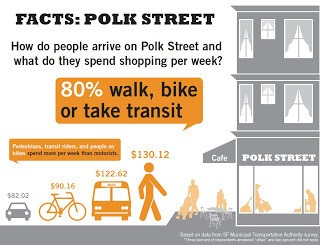 Fears on the part of Polk Street merchants that business will drop if bike lanes are added are unfounded. A study by the SFMTA shows people on foot and on bike visit Polk Street more often and spend more per week at local merchants than those who arrive by car. Both in New York and San Francisco, added bike lanes have resulted in increased business for local merchants. In addition, when bike lanes are added to a street, property values are shown to increase. Bike lanes help, not hurt, local business and property owners.
Fears on the part of Polk Street merchants that business will drop if bike lanes are added are unfounded. A study by the SFMTA shows people on foot and on bike visit Polk Street more often and spend more per week at local merchants than those who arrive by car. Both in New York and San Francisco, added bike lanes have resulted in increased business for local merchants. In addition, when bike lanes are added to a street, property values are shown to increase. Bike lanes help, not hurt, local business and property owners.Bicycling is also far cheaper to the taxpayer’s pocketbook. Every Muni ride is subsidized by the taxpayer $.61 per passenger mile. Right now San Francisco can’t even come up with funds to keep our buses in adequate repair, and many Muni lines are at capacity. Where will the money come from to pay for extra buses and drivers to service the new people moving in?
On the other hand, encouraging people to drive also costs us. Car drivers cover less than 15% of the direct cost of their city driving via gasoline and vehicle taxes. 85% is paid for out of the general fund. Compared to buses, trucks and cars (that have 100 to 500 times the mass), bikes inflict a micro amount of damage on the road, necessitating little or no repair or maintenance. When cars cause accidents, emergency personnel response and the subsequent clean up are funded by taxpayers. Health and environmental damage inflicted by cars and not paid for by the driver (for example from uninsured motorists, toxic residue, and particulate matter from car emissions) are paid for by the individual injured, the city of San Francisco, or society at large.
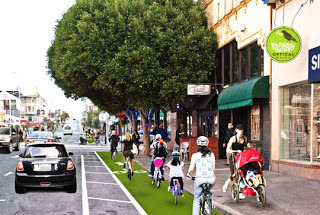 What could beFactoring in the direct costs of driving and the indirect cost of parking, land, crashes, congestion, and health damage due to air pollution (but not climate change or other environment-related costs), San Francisco subsidizes car driving $.53 every mile. Biking only costs $.01 for every mile.
What could beFactoring in the direct costs of driving and the indirect cost of parking, land, crashes, congestion, and health damage due to air pollution (but not climate change or other environment-related costs), San Francisco subsidizes car driving $.53 every mile. Biking only costs $.01 for every mile. Let’s repeat this. Cost to you, the taxpayer, per mile of passenger transport:Muni: $.61Private vehicle: $.53Bicycle: $.01Walk: $.00 (or very close. Mostly land costs for sidewalks.)
It’s the convenience.
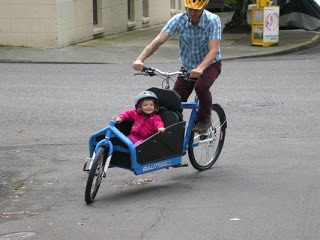 Easy-peasy electric-assist kid shuttlingIf we want people to go car-lite or car-free, it’s far easier for them to do this using a bike for transportation than relying on Muni. For trips under two miles, bikes are as fast as cars, twice as fast as Muni, and four times faster than walking. For trips under four miles, biking is just 5 to 10 minutes slower than driving and equal to Muni or faster. (It depends on how many transfers the particular Muni trip requires.) Though bicycles do get the occasional flat tire, they are far more reliable than Muni in getting you where you want to go. And if you live on a hill or have physical limitations, an ebike makes biking a breeze. (Hill + shuttling children? Electrified cargo bike!) In the Netherlands, bicycling is so safe and convenient most children bicycle to school and seniors bicycle well into their 70’s and even 80’s.
Easy-peasy electric-assist kid shuttlingIf we want people to go car-lite or car-free, it’s far easier for them to do this using a bike for transportation than relying on Muni. For trips under two miles, bikes are as fast as cars, twice as fast as Muni, and four times faster than walking. For trips under four miles, biking is just 5 to 10 minutes slower than driving and equal to Muni or faster. (It depends on how many transfers the particular Muni trip requires.) Though bicycles do get the occasional flat tire, they are far more reliable than Muni in getting you where you want to go. And if you live on a hill or have physical limitations, an ebike makes biking a breeze. (Hill + shuttling children? Electrified cargo bike!) In the Netherlands, bicycling is so safe and convenient most children bicycle to school and seniors bicycle well into their 70’s and even 80’s.It’s the safety.
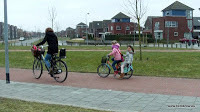 Cycling can be quite safe. (aviewfromthecyclepath.com)Polk Street has one of the highest rates of cars injuring bicyclists of any street in the city. Bicyclists are injured on Polk Street at four times the rate of other streets with comparable numbers of bike riders (Harrison and Arguello.) In 2006, a young woman bicyclist was killed by a hit and run driver on Polk Street. Many, many others since then have had bones (arms, hips, legs, elbows) shattered, on average 20 or so injuries a year. Keeping Polk Street as it is ensures that more deaths and injuries will occur, often to young people under 30 who are sons and daughters of someone and are just trying to lead decent lives on not a whole lot of income. Streets with protected bike lanes are proven to have lower bicyclist injury rates. Surprisingly, streets with protected bike lanes have also shown to have lower pedestrian injury rates. Better-designed streets save lives and reduce our collective health care costs by not necessitating hospital stays, MRIs, blood transfusions, etc.
Cycling can be quite safe. (aviewfromthecyclepath.com)Polk Street has one of the highest rates of cars injuring bicyclists of any street in the city. Bicyclists are injured on Polk Street at four times the rate of other streets with comparable numbers of bike riders (Harrison and Arguello.) In 2006, a young woman bicyclist was killed by a hit and run driver on Polk Street. Many, many others since then have had bones (arms, hips, legs, elbows) shattered, on average 20 or so injuries a year. Keeping Polk Street as it is ensures that more deaths and injuries will occur, often to young people under 30 who are sons and daughters of someone and are just trying to lead decent lives on not a whole lot of income. Streets with protected bike lanes are proven to have lower bicyclist injury rates. Surprisingly, streets with protected bike lanes have also shown to have lower pedestrian injury rates. Better-designed streets save lives and reduce our collective health care costs by not necessitating hospital stays, MRIs, blood transfusions, etc. 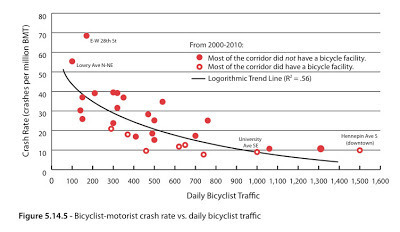 Data from the Twin CitiesThough most people enjoy bike riding, currently the vast majority of San Franciscans won’t ride bikes because they are unwilling to duke it out with cars in our stressful traffic. Safety is an issue, but it’s proven that stress is the bigger one. Studies show that creating a network of low-stress, connected bikeways (protected, separated bike lanes that cars and delivery trucks can’t continually double-park in) is the greatest single determinant in whether the average person will use a bicycle for transportation. Studies show that the more people bicycle, the more the rate of bicycle injury drops, partly because motorists grow to expect and watch for bicyclists and partly because on streets calmed by bike lanes and lots of bicyclists it's harder for motorists to speed. (Speed kills. The lower speeds are why the more people bicycle, the fewer pedestrian and car driver and car passenger injuries there are as well.) Encouraging bicyclists with their own low-stress space in and of itself produces safety for all road users.
Data from the Twin CitiesThough most people enjoy bike riding, currently the vast majority of San Franciscans won’t ride bikes because they are unwilling to duke it out with cars in our stressful traffic. Safety is an issue, but it’s proven that stress is the bigger one. Studies show that creating a network of low-stress, connected bikeways (protected, separated bike lanes that cars and delivery trucks can’t continually double-park in) is the greatest single determinant in whether the average person will use a bicycle for transportation. Studies show that the more people bicycle, the more the rate of bicycle injury drops, partly because motorists grow to expect and watch for bicyclists and partly because on streets calmed by bike lanes and lots of bicyclists it's harder for motorists to speed. (Speed kills. The lower speeds are why the more people bicycle, the fewer pedestrian and car driver and car passenger injuries there are as well.) Encouraging bicyclists with their own low-stress space in and of itself produces safety for all road users.Encouraging bicyclists to ride through a neighborhood also adds safety by deterring crime through more eyes on the street. Motorists speed through neighborhoods noticing little. Bicyclists have no obstructions or blind spots. They see everything.
It’s the health.
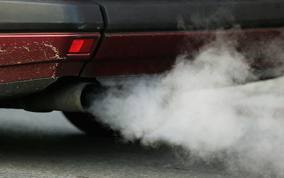 NastyCar exhaust is a proven cause of asthma, heart disease, and cancer. Bike lanes provide a little extra room to allow the toxins of car exhaust to disperse before a cyclist must breathe them in. It makes a significant difference. (This is also one of the reasons why at red lights bicyclists wait at the front of your car, not near your tailpipe.)
NastyCar exhaust is a proven cause of asthma, heart disease, and cancer. Bike lanes provide a little extra room to allow the toxins of car exhaust to disperse before a cyclist must breathe them in. It makes a significant difference. (This is also one of the reasons why at red lights bicyclists wait at the front of your car, not near your tailpipe.)The more people bike, the healthier they are. Studies show that people who bike to work have fewer sick days and are more productive when they are at work. They also are happier, live longer, have more years of healthy life, and require less dollars of medical treatment each year than people who drive to work. If companies have access to a healthy workforce, their health care costs are lower. This gives these companies a competitive advantage. (Health care costs account for nearly 10% of average employee compensation expense.) In addition, unless they are hit by cars, healthy people have much less reason to visit the SF General emergency room. When people can’t pay for their visit to the SF General ER, we all pay.
Though for half a century Americans have tried to arrange their lives to avoid all forms of physical exertion, it turns out that the human body becomes sickly if it doesn’t get 30 minutes of moderate exercise a day. (Studies also show that the more hours spent driving, the more unhealthy you are.) Incorporating this moderate exercise into one’s transportation is the most reliable and least costly way of obtaining it. Creating a physical environment where driving is encouraged while walking and bicycling are kept dangerous and miserable is a tragedy for human health. The city of Copenhagen goes out of its way to encourage its citizens to bicycle for transportation because they estimate they save 42 cents in health care costs for every mile biked.
It’s the energy.This is so big, it’s hard to know where to begin. If you’re reading this on-line, check here, here and here. Suffice it to say that per capita oil consumption in the US has been dropping and will continue to drop whether we like it or not. This mostly won’t be through greater fuel efficiency, but rather from people going car-lite and car-free altogether. (It’s already happening.) In addition, total energy consumed per person is dropping in the US and will continue to drop whether we like it or not. San Francisco already consumes less total energy per person than almost anywhere in the US. The more San Francisco facilitates its citizens to use less energy, the more economically competitive our city will be and also the more resilient. Cars are huge energy-slurping machines, even electric ones. Making it possible for the average person to live well without a car will protect San Francisco from many of the negative impacts of world net energy decline. Car-intensive, high energy-consuming regions, in contrast, will find themselves mired in economic contraction. Be glad you live in San Francisco where there is some form of transit and people willing to walk and bicycle. (If you live within walking distance of a BART or Caltrain station, you are doubly blessed.) Our transit, biking, walking, and energy efficiency may very well be what allows San Francisco to prosper in the years shortly ahead.
It’s the planet.This is real. Climate change due to humans burning fossil fuels is happening. Cars and coal are on their way to making much of the planet uninhabitable. The only ones denying it are those making a profit from the status quo or those who get their information from Fox News. If in ten years you don’t expect to be alive, nor any one you love, then, sure, you’ll skip most of the worst impacts. Why be inconvenienced? But if you have compassion for the folks who won’t escape the famine, the refugees, the heat waves, the disease, the extinction of most large mammal species, not to mention the potential utter collapse of civilization, you might feel a bit overwhelmed.
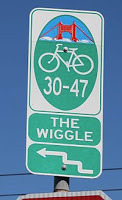
Here’s a deal. For 2013, you don’t need to buy carbon offsets or get rid of your car (unless you’d like to rid yourself of $9000/year of costs.) What you can do to lower your city’s carbon footprint is simply support others who are already trying to live carbon-free. Avoid driving high bicycle corridors like the Wiggle, drive gently around bicyclists when you pass them on side streets, and stop griping that they don’t stop at stop signs. (Yes, bicyclists should absolutely yield to pedestrians and other traffic that have the right of way! But the second you are on a bike you’ll see why it’s sensible and safe to slow down in order to yield rather than completely stop.) And, first and foremost, encourage bicyclists by having your city give them just a little space so that biking does not end up killing them and making their mothers bitter to the end of time. That’s all. Even if you can’t stop driving right now, that’s what you can do this year to contribute. It’s nuts that San Francisco has voted to divest its retirement funds from fossil fuel industries but won’t take the simplest of steps to support those trying to live fossil fuel-free lives.
It’s the future.Car traffic does not help Polk Street, it hurts it. Bike lanes will bring bicyclists from all over the city to Polk who would not come otherwise. Bike lanes will bring tourists traversing between the Civic Center and Ghirardelli Square/Fort Mason. People like to shop and linger on streets that are pleasant, hospitable and safe, not ones filled with noise, pollution, filth, crime and danger. Because Polk Street is the geographic center of the NE quadrant of the city and a natural place for people to congregate, reduced car parking, car pollution and car noise could cause Polk to absolutely blossom both as a neighborhood and as a destination.
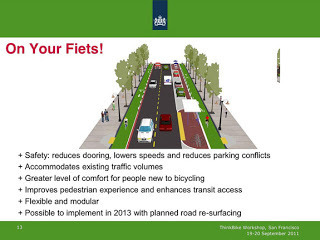 City living doesn't have to be polluted, ugly and dangerous.
City living doesn't have to be polluted, ugly and dangerous.Pay attention to the hurricanes, the droughts, the fires, the floods, the food shortages this summer. Note the riots, the uprisings, and the revolutions. Realize what you do this year and next counts. Your children and grandchildren will remember it. Which side will you stand with, the one speaking for them, or the one that will, without a qualm, sacrifice the future for the sake of not walking two extra blocks? We need to design a Polk Street that will work for the reality close at hand in 2015, not fearfully preserve at all costs (and in the face of all reason) the Polk of 1995.
Protected bike lanes (in both directions) on Polk Street matter. Contact any or all of the following: the San Francisco Metro Transit Authority , the SFMTA Board of Directors, Mayor Ed Lee, Board of Supervisors President David Chiu, and/or your own city supervisor. Tell them you heartily support protected bike lanes on Polk Street and the city's fossil-free future.
Published on May 05, 2013 17:00
April 23, 2013
The Pluses and Minuses of Electric Bikes
[image error] Wild for e-bikes (The Economist)Electric-assist bicycles are outselling electric cars. This is happening by a small margin in the US and by a huge margin in Europe, 62 to1. Worldwide last year (taking into the account the Chinese) the ratio of electric bikes sold to electric cars was 244 to 1. In China there are now more e-bikes on the road than all cars (electric or regular) put together.
I think this is great. E-bikes take far less energy and materials to produce than electric cars, they need far smaller batteries, and they consume far less energy per mile of travel. Of course the energy per mile required varies depending on how much the rider pedals, but even if the rider doesn’t pedal at all, the amount of mass being moved is roughly 7% of the mass of the same rider in a small car. Electric assist bikes require 40 – 70 BTUs of energy per mile while a small electric car requires 1200. (An average internal-combustion-powered car requires over 4000 BTUs per mile.)
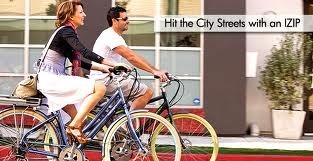 Easier to bike in heels than walk in them. (Currietech.com)Most states legally limit e-bikes to top speeds of 20 mph. Many e-bikes are limited through their electric controllers to 15 mph. Though some people worry about crazy, unlicensed e-bike riders, any two-wheeler that can go 30mph on flats without pedaling is not an e-bike—it’s an electric scooter. It is easy to create legislation that limits all e-bikes sold in a given state to top speeds of 15 mph, slower than your average twenty-something regular bicyclist. If your state hasn’t done this, your legislators should get to work.
Easier to bike in heels than walk in them. (Currietech.com)Most states legally limit e-bikes to top speeds of 20 mph. Many e-bikes are limited through their electric controllers to 15 mph. Though some people worry about crazy, unlicensed e-bike riders, any two-wheeler that can go 30mph on flats without pedaling is not an e-bike—it’s an electric scooter. It is easy to create legislation that limits all e-bikes sold in a given state to top speeds of 15 mph, slower than your average twenty-something regular bicyclist. If your state hasn’t done this, your legislators should get to work.My husband and I both have electric-assist bikes. They are great for zipping up and down the rather large hill we live on. We don’t ride them much because we enjoy riding our regular bikes more, but for grocery shopping my bike with an Xtracycle attachment cannot be beat. (It can carry five bags of groceries. Uphill. With no sweat.) It also on occasion transports children, even large, teen-sized ones.
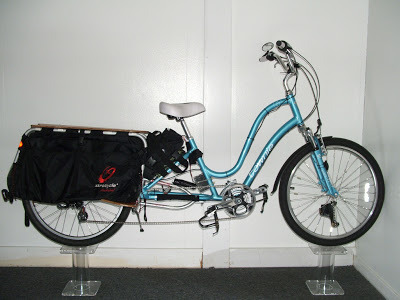 Goddess-like SUV of bikes
Goddess-like SUV of bikesMy husband uses his electric bike to dash to the store or to pick up Chinese takeout on a day when he’s already biked a ton and wants to take it easy. (Again, we live on a big, big hill.) Having the two e-bikes and a membership in a carshare program gave us the confidence to drop down from two cars to one, a step that, at this point, has saved us tens of thousands of dollars. While access to carshare has proven handy, after four years we find we use our e-bikes a hundred times more.
An electric-assist fundamentally helps you fight gravity. Riding an electric-assist bike means you are guaranteed not to arrive sweaty at your destination. It makes transporting heavy things easy. It takes you up hills without panting. I find the boost in acceleration also allows me to spend less time in intersections, places bicyclists are most at risk. And when you’re just feeling tired and/or lazy, an electric-assist bike can keep you out of your car because, except in a full downpour, it’s truly as easy as driving. For short trips it’s usually faster. Plus, an e-bike is fun the same way riding a bike is fun, especially if you can ride on quiet streets away from car traffic. When you have the motor on, it makes a quiet hum and you feel as if a gentle hand is pushing you along. On it you breathe fresh air, you see the sky, trees and birds, you experience your city or town in a different way. It offers a far richer sensory experience than being inside any car does.
But there are drawbacks. After four years riding an electric-assist bicycle, I think I’m qualified to enumerate them.
1) Riding an electric-assist bike provides less exercise than a regular bike. This is why I began to ride mine less and less. Let’s be clear—an electric-assist bike provides way, way, way more exercise than driving a car (which basically requires zero.) And it does depend on how much you pedal. But I estimate on my electric bike I get two-thirds less exercise than on my regular one. I pedal constantly on my electric bike and use the motor only when I’m fighting gravity—going up a hill or accelerating from a stop. I can generally keep my quite heavy bike in motion on the flats without the motor at all. Still, it is fighting gravity on a bicycle that requires the effort and provides the exercise. So when you use a motor instead of your own effort for this, it just doesn’t have the same exercise effect.2) [image error] Gorgeous but not cheap (Faraday Porteur)An electric-assist bike is four to five times the cost of a regular bike. For $500 you can get a pretty nice regular bike. A decent electric bike that won’t fall apart in a year will cost more between $1500 and $3000. Both kinds of bikes will require yearly maintenance—a bicycle around $50 - 100, an e-bike around $100 -150? (Depends how many miles you put on your bike as to how much maintenance you will need.) On my bike, after the second year my controller shorted out and I needed a new one. (Part of this may be due to the fact that my bike was creatively created out of a kit and may have been more prone to shorting due to bad San Francisco pavement than a better-designed bike.) That cost me $300. After year 3, I needed a new battery. That cost me $800. The good news is in those three years, battery technology improved, and I got a bigger, more powerful battery that was roughly the same size and weight of my previous battery. My husband also had to replace the battery on his electric bike after three years. Better battery technology in the future may extend battery life, but I would say right now count on replacing the battery every three years. The good news is that brushless electric motors tend to have very little go wrong and should last a long, long time.3) Electric-assist bikes are heavier than regular bikes. My electric-assist is a whopping 80 lbs, but that’s because I have a heavier-than-average bicycle with an Xtracycle attachment on it. Most e-bikes are 40 to 50 lbs while regular bikes weigh 25 – 30 lbs. This means you cannot carry an e-bike easily up a set of stairs, onto trains, hoist it onto the top of a two-tier bike rack, or put it on a bike carrier on the back of your car. (My husband’s ebike does fold up and fits in the rear of our hatchback car.) Though I don’t liketo carry my regular bike up and down flights of stairs, I can do it. With an e-bike there’s no way.4) The bigger the investment, the more worry about it being stolen. However, right now it is far easier to fence regular bikes than e-bikes, so I would say regular bikes are more vulnerable for the time being. [image error] Bike that bridge5) You cannot go infinitely far on an electric bike before you run out of juice. My bike has a range of 10 – 11 miles. Most e-bikes have a range of 15 – 20. (Their published, theoretical ranges may be higher than what you experience in reality, and certainly higher than what you will experience after a year of use!) On a regular bike, I’ve been known to go 44 miles in a day, though this is certainly not usual for me. However, even if I just want to go from my house in San Francisco to Sausalito for brunch, taking an e-bike is not an option unless I want to also bring the charger and then go hunt/beg for an electrical outlet.6)
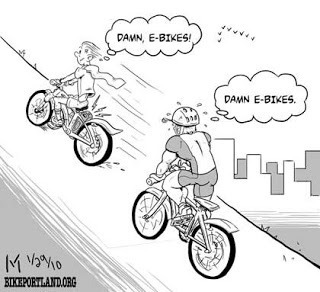 (Mark Markovich, BikePortland.org)Some regular bike riders resent electric-assist bikes. (This is less true if you are older and they figure you have an excuse.) When I ride my regular bike, I have a twinge of this—just sheer envy as the person on an e-bike pulls away from the green light faster than me. Rather than feel grateful the person is not spitting out poisonous exhaust fumes or mashing me into a pulp as they turn right without looking, I feel resentment that the rider is cheating on the communal fight against gravity. This is silly. Anyone on a regular bike has much in common with someone an e-bike. Both are equally vulnerable to car traffic, both have every reason to want good bicycle infrastructure, and both are transporting themselves in ways that don’t damage the environment.
(Mark Markovich, BikePortland.org)Some regular bike riders resent electric-assist bikes. (This is less true if you are older and they figure you have an excuse.) When I ride my regular bike, I have a twinge of this—just sheer envy as the person on an e-bike pulls away from the green light faster than me. Rather than feel grateful the person is not spitting out poisonous exhaust fumes or mashing me into a pulp as they turn right without looking, I feel resentment that the rider is cheating on the communal fight against gravity. This is silly. Anyone on a regular bike has much in common with someone an e-bike. Both are equally vulnerable to car traffic, both have every reason to want good bicycle infrastructure, and both are transporting themselves in ways that don’t damage the environment.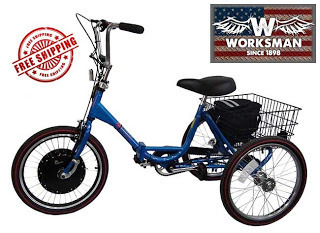 For us aging boomersIn general, if you are in decent health, under 65 and live somewhere without big hills, I would say an e-bike isn’t worth the extra cost and hassle. Regular bikes are very easy to ride except on steep hills, and, if you go slowly enough, take no more exertion (or sweat) than a pleasant walk. However, if right now you are limited from riding a bicycle due to health issues, hills, or you really cannot arrive at your destination with even a drop of perspiration, then an electric-assist bike might really be great for you. If balance or other issues prevent you from riding a bicycle, an electric-assist three-wheeler might open up the world in a way you never thought possible. Read this review from an amputee.
For us aging boomersIn general, if you are in decent health, under 65 and live somewhere without big hills, I would say an e-bike isn’t worth the extra cost and hassle. Regular bikes are very easy to ride except on steep hills, and, if you go slowly enough, take no more exertion (or sweat) than a pleasant walk. However, if right now you are limited from riding a bicycle due to health issues, hills, or you really cannot arrive at your destination with even a drop of perspiration, then an electric-assist bike might really be great for you. If balance or other issues prevent you from riding a bicycle, an electric-assist three-wheeler might open up the world in a way you never thought possible. Read this review from an amputee.Forty percent of all trips made in the US are under two miles in length. Currently Americans drive 2/3rds of all trips under two miles. (American even drive 60% of trips under 1 mile!) Two miles on an e-bike takes ten minutes. Unless you live on a 55 mph highway, two miles in your car probably takes between eight minutes and twelve. Seriously. Time it next time from your house to the store and see how long it takes. (Include parking time.) For short trips, an e-bike is as fast and convenient as a car.
The world is changing. Gasoline will get more expensive, and energy in general will be getting more expensive per BTU for reasons I describe here. More and more communities are building bike lanes and bike paths. Cities are getting denser and so driving a car in them will only get more difficult (as I describe here.) Climate change means we can’t keep burning fossil fuels. An electric bicycle can be the way you address all these issues, get more exercise, and improve your health to boot. Plus, if you can replace car trips or even downsize a car by relying on an e-bike instead, you will save a great deal of money--$5000-$8000 per year (this is after factoring in e-bike costs). And if there is a gasoline shortage for any reason, you are home free.
Published on April 23, 2013 17:44
April 22, 2013
Wildflowers of Twin Peaks
Published on April 22, 2013 14:37
April 18, 2013
The Disappearing Urban Car (Why Successful Cities Will Be Largely Car-free by the End of 2015)
<!-- /* Font Definitions */ @font-face {font-family:"MS 明朝"; panose-1:0 0 0 0 0 0 0 0 0 0; mso-font-charset:128; mso-generic-font-family:roman; mso-font-format:other; mso-font-pitch:fixed; mso-font-signature:1 134676480 16 0 131072 0;} @font-face {font-family:"Cambria Math"; panose-1:2 4 5 3 5 4 6 3 2 4; mso-font-charset:0; mso-generic-font-family:auto; mso-font-pitch:variable; mso-font-signature:-536870145 1107305727 0 0 415 0;} @font-face {font-family:Cambria; panose-1:2 4 5 3 5 4 6 3 2 4; mso-font-charset:0; mso-generic-font-family:auto; mso-font-pitch:variable; mso-font-signature:-536870145 1073743103 0 0 415 0;} /* Style Definitions */ p.MsoNormal, li.MsoNormal, div.MsoNormal {mso-style-unhide:no; mso-style-qformat:yes; mso-style-parent:""; margin:0in; margin-bottom:.0001pt; mso-pagination:widow-orphan; font-size:12.0pt; font-family:Cambria; mso-ascii-font-family:Cambria; mso-ascii-theme-font:minor-latin; mso-fareast-font-family:"MS 明朝"; mso-fareast-theme-font:minor-fareast; mso-hansi-font-family:Cambria; mso-hansi-theme-font:minor-latin; mso-bidi-font-family:"Times New Roman"; mso-bidi-theme-font:minor-bidi;} p.MsoListParagraph, li.MsoListParagraph, div.MsoListParagraph {mso-style-priority:34; mso-style-unhide:no; mso-style-qformat:yes; margin-top:0in; margin-right:0in; margin-bottom:0in; margin-left:.5in; margin-bottom:.0001pt; mso-add-space:auto; mso-pagination:widow-orphan; font-size:12.0pt; font-family:Cambria; mso-ascii-font-family:Cambria; mso-ascii-theme-font:minor-latin; mso-fareast-font-family:"MS 明朝"; mso-fareast-theme-font:minor-fareast; mso-hansi-font-family:Cambria; mso-hansi-theme-font:minor-latin; mso-bidi-font-family:"Times New Roman"; mso-bidi-theme-font:minor-bidi;} p.MsoListParagraphCxSpFirst, li.MsoListParagraphCxSpFirst, div.MsoListParagraphCxSpFirst {mso-style-priority:34; mso-style-unhide:no; mso-style-qformat:yes; mso-style-type:export-only; margin-top:0in; margin-right:0in; margin-bottom:0in; margin-left:.5in; margin-bottom:.0001pt; mso-add-space:auto; mso-pagination:widow-orphan; font-size:12.0pt; font-family:Cambria; mso-ascii-font-family:Cambria; mso-ascii-theme-font:minor-latin; mso-fareast-font-family:"MS 明朝"; mso-fareast-theme-font:minor-fareast; mso-hansi-font-family:Cambria; mso-hansi-theme-font:minor-latin; mso-bidi-font-family:"Times New Roman"; mso-bidi-theme-font:minor-bidi;} p.MsoListParagraphCxSpMiddle, li.MsoListParagraphCxSpMiddle, div.MsoListParagraphCxSpMiddle {mso-style-priority:34; mso-style-unhide:no; mso-style-qformat:yes; mso-style-type:export-only; margin-top:0in; margin-right:0in; margin-bottom:0in; margin-left:.5in; margin-bottom:.0001pt; mso-add-space:auto; mso-pagination:widow-orphan; font-size:12.0pt; font-family:Cambria; mso-ascii-font-family:Cambria; mso-ascii-theme-font:minor-latin; mso-fareast-font-family:"MS 明朝"; mso-fareast-theme-font:minor-fareast; mso-hansi-font-family:Cambria; mso-hansi-theme-font:minor-latin; mso-bidi-font-family:"Times New Roman"; mso-bidi-theme-font:minor-bidi;} p.MsoListParagraphCxSpLast, li.MsoListParagraphCxSpLast, div.MsoListParagraphCxSpLast {mso-style-priority:34; mso-style-unhide:no; mso-style-qformat:yes; mso-style-type:export-only; margin-top:0in; margin-right:0in; margin-bottom:0in; margin-left:.5in; margin-bottom:.0001pt; mso-add-space:auto; mso-pagination:widow-orphan; font-size:12.0pt; font-family:Cambria; mso-ascii-font-family:Cambria; mso-ascii-theme-font:minor-latin; mso-fareast-font-family:"MS 明朝"; mso-fareast-theme-font:minor-fareast; mso-hansi-font-family:Cambria; mso-hansi-theme-font:minor-latin; mso-bidi-font-family:"Times New Roman"; mso-bidi-theme-font:minor-bidi;} .MsoChpDefault {mso-style-type:export-only; mso-default-props:yes; font-family:Cambria; mso-ascii-font-family:Cambria; mso-ascii-theme-font:minor-latin; mso-fareast-font-family:"MS 明朝"; mso-fareast-theme-font:minor-fareast; mso-hansi-font-family:Cambria; mso-hansi-theme-font:minor-latin; mso-bidi-font-family:"Times New Roman"; mso-bidi-theme-font:minor-bidi;} @page WordSection1 {size:8.5in 11.0in; margin:1.0in 1.25in 1.0in 1.25in; mso-header-margin:.5in; mso-footer-margin:.5in; mso-paper-source:0;} div.WordSection1 {page:WordSection1;} /* List Definitions */ @list l0 {mso-list-id:614144087; mso-list-type:hybrid; mso-list-template-ids:-7676660 67698703 67698713 67698715 67698703 67698713 67698715 67698703 67698713 67698715;} @list l0:level1 {mso-level-tab-stop:none; mso-level-number-position:left; text-indent:-.25in;} @list l0:level2 {mso-level-number-format:alpha-lower; mso-level-tab-stop:none; mso-level-number-position:left; text-indent:-.25in;} @list l0:level3 {mso-level-number-format:roman-lower; mso-level-tab-stop:none; mso-level-number-position:right; text-indent:-9.0pt;} @list l0:level4 {mso-level-tab-stop:none; mso-level-number-position:left; text-indent:-.25in;} @list l0:level5 {mso-level-number-format:alpha-lower; mso-level-tab-stop:none; mso-level-number-position:left; text-indent:-.25in;} @list l0:level6 {mso-level-number-format:roman-lower; mso-level-tab-stop:none; mso-level-number-position:right; text-indent:-9.0pt;} @list l0:level7 {mso-level-tab-stop:none; mso-level-number-position:left; text-indent:-.25in;} @list l0:level8 {mso-level-number-format:alpha-lower; mso-level-tab-stop:none; mso-level-number-position:left; text-indent:-.25in;} @list l0:level9 {mso-level-number-format:roman-lower; mso-level-tab-stop:none; mso-level-number-position:right; text-indent:-9.0pt;} ol {margin-bottom:0in;} ul {margin-bottom:0in;} </style>--> <br /><div class="MsoNormal" style="text-align: justify;"><span style="mso-spacerun: yes;"></span>In Part One of this series, <a href="http://karenlynnallen.blogspot.com/20..." target="_blank">It’s the Energy!</a>, we examined how US per capita total energy consumption has been dropping and will drop further over the next three years. In addition, I proposed that US oil energy use will somehow drop 32% by the end of 2015 without car mileage improving or gas prices rising much above $5 a gallon. </div><div class="MsoNormal"><br /></div><div class="MsoNormal">How could this possibly happen?</div><div class="MsoNormal"><br /></div><div class="MsoNormal" style="text-align: justify;">Reduction of per capita oil consumption will occur through extensions of trends that are already in progress, if we have the eyes to see them. Below is the pertinent list. I will * the trends already happening in the US, and I will # the ones I currently see happening all around me, especially in San Francisco, but also in the greater Bay Area.</div><div class="MsoNormal"><br /></div><div class="separator" style="clear: both; text-align: center;"><a href="http://4.bp.blogspot.com/-N4QlgeQy8Bg..." imageanchor="1" style="margin-left: 1em; margin-right: 1em;"><img border="0" height="275" src="http://4.bp.blogspot.com/-N4QlgeQy8Bg..." width="400" /></a></div><div class="MsoListParagraphCxSpFirst" style="text-align: justify; text-indent: -0.25in;"><span style="mso-bidi-font-family: Cambria; mso-bidi-theme-font: minor-latin; mso-fareast-font-family: Cambria; mso-fareast-theme-font: minor-latin;"><span style="mso-list: Ignore;">1.<span style="font: 7.0pt "Times New Roman";"><span style="font-family: Cambria;"> </span></span></span></span>Gas consumption will decline because vehicle miles traveled (VMT) per person will drop.<span style="mso-spacerun: yes;"> </span>*</div><div class="separator" style="clear: both; text-align: justify;"><span style="mso-bidi-font-family: Cambria; mso-bidi-theme-font: minor-latin; mso-fareast-font-family: Cambria; mso-fareast-theme-font: minor-latin;"><span style="mso-list: Ignore;"> <span style="font-size: small;">2.</span><span style="font: 7.0pt "Times New Roman";"> </span></span></span><span style="font-size: small;">Vehicle miles traveled will drop somewhat due to lower VMT/vehicle, but more due to fewer vehicles per person. *</span></div><div class="separator" style="clear: both; text-align: justify;"><span style="font-size: x-small;"><br /></span></div><div class="separator" style="clear: both; text-align: center;"><a href="http://2.bp.blogspot.com/-5kCqjLSv8bU..." imageanchor="1" style="margin-left: 1em; margin-right: 1em;"><img border="0" height="270" src="http://2.bp.blogspot.com/-5kCqjLSv8bU..." width="400" /></a></div><div class="separator" style="clear: both; text-align: justify;"><span style="font-size: x-small;"><br /></span></div><br /><div class="separator" style="clear: both; text-align: center;"></div><div class="MsoListParagraphCxSpMiddle" style="text-align: justify; text-indent: -0.25in;"><span style="mso-bidi-font-family: Cambria; mso-bidi-theme-font: minor-latin; mso-fareast-font-family: Cambria; mso-fareast-theme-font: minor-latin;"><span style="mso-list: Ignore;">3.<span style="font: 7.0pt "Times New Roman";"> </span></span></span>Improved fuel economy of the US vehicle fleet will not factor into reduced oil use much at all. Though it may seem extraordinary, per the EIA, average fuel economy of all classes of vehicles in the US (cars, SUVs, heavy trucks—you name it!) has gone down the last three years, not up, even with gas prices doubling. As a nation we appear utterly incapable of driving fuel-efficient cars. *</div><div class="MsoListParagraphCxSpMiddle" style="mso-list: l0 level1 lfo1; text-indent: -.25in;"><br /></div><div class="separator" style="clear: both; text-align: center;"><a href="http://1.bp.blogspot.com/-bnR6C17o4Ro..." imageanchor="1" style="margin-left: 1em; margin-right: 1em;"><img border="0" height="273" src="http://1.bp.blogspot.com/-bnR6C17o4Ro..." width="400" /></a></div><div class="MsoListParagraphCxSpMiddle" style="text-align: justify; text-indent: -0.25in;"><span style="mso-bidi-font-family: Cambria; mso-bidi-theme-font: minor-latin; mso-fareast-font-family: Cambria; mso-fareast-theme-font: minor-latin;"><span style="mso-list: Ignore;">4.<span style="font: 7.0pt "Times New Roman";"> </span></span></span>Average age of cars will continue to increase. (It's currently close to 11.3 years for cars and light trucks. That's up from 11.1 in 2012.) As real incomes decline for the bottom 80%, and car-related expenses increase as a percentage of household expenditures, few will be able to afford an electric or any other kind of new car. The price of used cars will rise and become prohibitive for many. (Between 2007 and 2012, the average price of a used car rose 33% to $8,495. The average price of a new car the same period rose 9%, to 30,545.) *</div><div class="MsoListParagraphCxSpMiddle" style="text-align: justify; text-indent: -0.25in;"><span style="mso-bidi-font-family: Cambria; mso-bidi-theme-font: minor-latin; mso-fareast-font-family: Cambria; mso-fareast-theme-font: minor-latin;"><span style="mso-list: Ignore;">5.<span style="font: 7.0pt "Times New Roman";"> </span></span></span>Even if multitudes could afford electric cars, no more than 10% of the US vehicle fleet will be electric by 2015 because not enough additional electricity will be available nor will the US electrical grid be capable of delivering it if it were. Electric cars make up less than ½ of a percent of vehicles in the US right now. * (See note about electric cars at end of post.)</div><div class="separator" style="clear: both; text-align: center;"></div><div class="MsoListParagraphCxSpMiddle" style="text-align: justify; text-indent: -0.25in;"><span style="mso-bidi-font-family: Cambria; mso-bidi-theme-font: minor-latin; mso-fareast-font-family: Cambria; mso-fareast-theme-font: minor-latin;"><span style="mso-list: Ignore;">6.<span style="font: 7.0pt "Times New Roman";"> </span></span></span>Vehicle miles traveled will decline and vehicles per person will decline because people, especially those under 35 (a generation that has <a href="http://advisorperspectives.com/dshort..." target="_blank">declining realhousehold income</a> and heavy student loan debt), <a href="http://grist.org/list/millennials-lov..." target="_blank">will move to cities</a> where they can live well without a car or with limited car use. <span style="mso-spacerun: yes;"> </span>*</div><div class="MsoListParagraphCxSpMiddle" style="text-align: justify; text-indent: -0.25in;"><span style="mso-bidi-font-family: Cambria; mso-bidi-theme-font: minor-latin; mso-fareast-font-family: Cambria; mso-fareast-theme-font: minor-latin;"><span style="mso-list: Ignore;">7.<span style="font: 7.0pt "Times New Roman";"> </span></span></span>Millenials, the generation born between 1978 and 1995, are already the generation least likely to own cars or <a href="http://dc.streetsblog.org/2013/03/15/..." target="_blank">even be licensed to drive</a>. (This trend will accelerate.) This generation is also the one most concerned about climate change, possibly because they are certain to suffer its impacts. By the end of 2015, Millennials will constitute 36% of eligible voters and one third of actual voters. Their values, needs and desires will take precedence. *</div><div class="MsoListParagraphCxSpMiddle" style="text-align: justify; text-indent: -0.25in;"><span style="mso-bidi-font-family: Cambria; mso-bidi-theme-font: minor-latin; mso-fareast-font-family: Cambria; mso-fareast-theme-font: minor-latin;"><span style="mso-list: Ignore;">8.<span style="font: 7.0pt "Times New Roman";"> </span></span></span>Cities that currently have at least a core area with population density over 10,000/sq mile and some sort of light rail and bicycle infrastructure will attract most of those who wish to live well without a car. Sprawling cities and cities where the only form of transit is buses will attract comparatively fewer. Cities where car-driving is mandatory will likely lose population. *</div><div class="MsoListParagraphCxSpMiddle" style="mso-list: l0 level1 lfo1; text-indent: -.25in;"><span style="mso-bidi-font-family: Cambria; mso-bidi-theme-font: minor-latin; mso-fareast-font-family: Cambria; mso-fareast-theme-font: minor-latin;"><span style="mso-list: Ignore;">9.<span style="font: 7.0pt "Times New Roman";"> </span></span></span>Housing values will <a href="http://dc.streetsblog.org/2013/03/22/..." target="_blank">hold up better</a> in cities and towns with access to light rail than those without. *</div><div class="MsoListParagraphCxSpMiddle" style="text-align: justify; text-indent: -0.25in;"><span style="mso-bidi-font-family: Cambria; mso-bidi-theme-font: minor-latin; mso-fareast-font-family: Cambria; mso-fareast-theme-font: minor-latin;"><span style="mso-list: Ignore;">10.<span style="font: 7.0pt "Times New Roman";"> </span></span></span>People moving to cities where they can live well without a car will cause the population density in those cities to rise by 20 – 30% in a very short span of time. This will happen through creation of new housing, more people living per household, and current housing creatively offering more housing. (Garages and in-law units turned into apartments, etc.) *</div><div class="separator" style="clear: both; text-align: center;"><a href="http://4.bp.blogspot.com/-fZcbIFrt7NE..." imageanchor="1" style="clear: right; float: right; margin-bottom: 1em; margin-left: 1em;"><img border="0" height="241" src="http://4.bp.blogspot.com/-fZcbIFrt7NE..." width="320" /></a></div><br /><div class="MsoListParagraphCxSpMiddle" style="text-align: justify; text-indent: -0.25in;"><span style="mso-bidi-font-family: Cambria; mso-bidi-theme-font: minor-latin; mso-fareast-font-family: Cambria; mso-fareast-theme-font: minor-latin;"><span style="mso-list: Ignore;">11.<span style="font: 7.0pt "Times New Roman";"> </span></span></span>Car-enthusiast baby boomers will die off and will be replaced each year in the adult ranks by Millennials who would rather <a href="http://www.huffingtonpost.com/2013/03..." target="_blank">go without a car</a> than without their cell phone or computer. * (There are already 6.5 million more 20 – 35 year olds than there are 60+ year olds.)</div><div class="separator" style="clear: both; text-align: center;"></div><div class="MsoListParagraphCxSpMiddle" style="text-align: justify; text-indent: -0.25in;"><span style="mso-bidi-font-family: Cambria; mso-bidi-theme-font: minor-latin; mso-fareast-font-family: Cambria; mso-fareast-theme-font: minor-latin;"><span style="mso-list: Ignore;">12.<span style="font: 7.0pt "Times New Roman";"> </span></span></span>Owning a car will increase poverty in households with incomes under $20K and cause severe financial stress in households with incomes between 20-30K. # (There will actually be a term for this, “Car-Induced Poverty.”)</div><div class="MsoListParagraphCxSpMiddle" style="text-align: justify; text-indent: -0.25in;"><span style="mso-bidi-font-family: Cambria; mso-bidi-theme-font: minor-latin; mso-fareast-font-family: Cambria; mso-fareast-theme-font: minor-latin;"><span style="mso-list: Ignore;">13.<span style="font: 7.0pt "Times New Roman";"> </span></span></span>More people each year will choose <a href="http://money.usnews.com/money/persona..." target="_blank">smaller living space</a>, a walkable community and the ability to be car-free over larger living quarters in a car-dependent, long-commute suburb. #</div><div class="MsoListParagraphCxSpMiddle" style="text-align: justify; text-indent: -0.25in;"><span style="mso-bidi-font-family: Cambria; mso-bidi-theme-font: minor-latin; mso-fareast-font-family: Cambria; mso-fareast-theme-font: minor-latin;"><span style="mso-list: Ignore;">14.<span style="font: 7.0pt "Times New Roman";"> </span></span></span>Car-free individuals and households will have more disposable income to spend in their local economy. (84% of car-related expenditures leave the local economy. One-to-five-year-old cars cost <a href="http://www.nbcnews.com/business/aaa-c..." target="_blank">$9100/year</a> to own and operate. Even a ten-year-old car costs $4-6000/year, depending on location.) *</div><div class="MsoListParagraphCxSpMiddle" style="text-align: justify; text-indent: -0.25in;"><span style="mso-bidi-font-family: Cambria; mso-bidi-theme-font: minor-latin; mso-fareast-font-family: Cambria; mso-fareast-theme-font: minor-latin;"><span style="mso-list: Ignore;">15.<span style="font: 7.0pt "Times New Roman";"> </span></span></span>Car-free people are more inclined than car drivers to shop locally, improving local economies of car-light cities and neighborhoods. #</div><div class="MsoListParagraphCxSpMiddle" style="text-align: justify; text-indent: -0.25in;"><span style="mso-bidi-font-family: Cambria; mso-bidi-theme-font: minor-latin; mso-fareast-font-family: Cambria; mso-fareast-theme-font: minor-latin;"><span style="mso-list: Ignore;">16.<span style="font: 7.0pt "Times New Roman";"> </span></span></span>Car-light city neighborhoods will have a more vibrant local economy than car intensive neighborhoods, with more foot traffic, less crime, and busier stores, cafes, and restaurants. #</div><div class="MsoListParagraphCxSpMiddle" style="text-align: justify; text-indent: -0.25in;"><span style="mso-bidi-font-family: Cambria; mso-bidi-theme-font: minor-latin; mso-fareast-font-family: Cambria; mso-fareast-theme-font: minor-latin;"><span style="mso-list: Ignore;">17.<span style="font: 7.0pt "Times New Roman";"> </span></span></span>Malls and strip malls accessible only by car will continue to <a href="http://www.reuters.com/article/2013/0..." target="_blank">fare poorly</a> due to the dropping disposable income of their customer base as well as from losing market share to on-line shopping. Vacancy rates at strip malls and shopping malls only accessible by car will continue to rise. Many will close altogether. *</div><div class="MsoListParagraphCxSpMiddle" style="text-align: justify; text-indent: -0.25in;"><span style="mso-bidi-font-family: Cambria; mso-bidi-theme-font: minor-latin; mso-fareast-font-family: Cambria; mso-fareast-theme-font: minor-latin;"><span style="mso-list: Ignore;">18.<span style="font: 7.0pt "Times New Roman";"> </span></span></span>In suburbs and cities that are car-based and far removed from dense population centers housing values will drop, crime rates will rise, and city governments will be <a href="http://www.bloomberg.com/news/2013-04..." target="_blank">hard-pressed to provide basic</a> community services such as police and fire. #</div><div class="MsoListParagraphCxSpMiddle" style="mso-list: l0 level1 lfo1; text-indent: -.25in;"><span style="mso-bidi-font-family: Cambria; mso-bidi-theme-font: minor-latin; mso-fareast-font-family: Cambria; mso-fareast-theme-font: minor-latin;"><span style="mso-list: Ignore;">19.<span style="font: 7.0pt "Times New Roman";"> </span></span></span>As car ownership levels decline, taxis, car-sharing, transit, and trains will replace many urban car trips. In addition many novel forms of <a href="http://www.pcworld.com/article/203445..." target="_blank">ride-sharing</a> will spring up. #</div><table cellpadding="0" cellspacing="0" class="tr-caption-container" style="float: right; margin-left: 1em; text-align: right;"><tbody><tr><td style="text-align: center;"><a href="http://3.bp.blogspot.com/-GtuaugnZDQc..." imageanchor="1" style="clear: right; margin-bottom: 1em; margin-left: auto; margin-right: auto;"><img border="0" height="400" src="http://3.bp.blogspot.com/-GtuaugnZDQc..." width="293" /></a></td></tr><tr><td class="tr-caption" style="text-align: center;"><span style="font-family: Cambria;">San Francisco Corporate shuttle map (Stamen.com)</span></td></tr></tbody></table><div class="MsoListParagraphCxSpMiddle" style="text-align: justify; text-indent: -0.25in;"><span style="mso-bidi-font-family: Cambria; mso-bidi-theme-font: minor-latin; mso-fareast-font-family: Cambria; mso-fareast-theme-font: minor-latin;"><span style="mso-list: Ignore;">20.<span style="font: 7.0pt "Times New Roman";"> </span></span></span>As car ownership levels decline and city densities increase, large employers not located in dense cities will offer free corporate buses to shuttle city-living employees to and from work. #<span style="mso-spacerun: yes;"> </span>(Quite a few of these roll past my front door each day.)</div><div class="MsoListParagraphCxSpMiddle" style="text-align: justify; text-indent: -0.25in;"><span style="mso-bidi-font-family: Cambria; mso-bidi-theme-font: minor-latin; mso-fareast-font-family: Cambria; mso-fareast-theme-font: minor-latin;"><span style="mso-list: Ignore;">21.<span style="font: 7.0pt "Times New Roman";"> </span></span></span>As city densities increase, bike and walking will replace many car trips. #<span style="mso-spacerun: yes;"> </span>(Though public transit is more energy efficient than private cars, the greatest drop in transportation energy consumption occurs when people live close enough to goods and services to make these trips by foot or bike.) #</div><div class="MsoListParagraphCxSpMiddle" style="text-align: justify; text-indent: -0.25in;"><span style="mso-bidi-font-family: Cambria; mso-bidi-theme-font: minor-latin; mso-fareast-font-family: Cambria; mso-fareast-theme-font: minor-latin;"><span style="mso-list: Ignore;">22.<span style="font: 7.0pt "Times New Roman";"> </span></span></span>As cities grow in density, they will offer convenient <a href="http://www.streetsblog.org/2013/04/17..." target="_blank">bikeshare</a> stations to increase trips by bicycle. In addition many small and medium-sized deliveries will be made by electric-assist bicycle. * (Because each transit trip is subsidized 20 – 75%, cities will have huge incentives to encourage biking and walking. Both lower health care costs, take little space, and cost governments almost almost nothing.)</div><div class="MsoListParagraphCxSpMiddle" style="text-align: justify; text-indent: -0.25in;"><span style="mso-bidi-font-family: Cambria; mso-bidi-theme-font: minor-latin; mso-fareast-font-family: Cambria; mso-fareast-theme-font: minor-latin;"><span style="mso-list: Ignore;">23.<span style="font: 7.0pt "Times New Roman";"> </span></span></span>People who strongly value a car-dependent lifestyle will move to the suburbs where housing is cheaper and driving is less difficult. (The money they save on housing they will spend on their car.) #</div><div class="MsoListParagraphCxSpMiddle" style="text-align: justify; text-indent: -0.25in;"><span style="mso-bidi-font-family: Cambria; mso-bidi-theme-font: minor-latin; mso-fareast-font-family: Cambria; mso-fareast-theme-font: minor-latin;"><span style="mso-list: Ignore;">24.<span style="font: 7.0pt "Times New Roman";"> </span></span></span>People who are happy to live without cars will move to cities and take their place. # (Right now it is already often <a href="http://dc.streetsblog.org/2012/10/19/..." target="_blank">cheaper for moderate income</a> renters to live in expensive cities without a car than in cheaper places with one.) </div><div class="MsoListParagraphCxSpMiddle" style="text-align: justify; text-indent: -0.25in;"><span style="mso-bidi-font-family: Cambria; mso-bidi-theme-font: minor-latin; mso-fareast-font-family: Cambria; mso-fareast-theme-font: minor-latin;"><span style="mso-list: Ignore;">25.<span style="font: 7.0pt "Times New Roman";"> </span></span></span>People living in cities will live in less square footage that they have to heat and light, so their non-transportation energy consumption will also be lower. *</div><div class="MsoListParagraphCxSpMiddle" style="text-align: justify; text-indent: -0.25in;"><span style="mso-bidi-font-family: Cambria; mso-bidi-theme-font: minor-latin; mso-fareast-font-family: Cambria; mso-fareast-theme-font: minor-latin;"><span style="mso-list: Ignore;">26.<span style="font: 7.0pt "Times New Roman";"> </span></span></span>As cities grow in density, there will be even less space available for cars and car-related infrastructure. #</div><table cellpadding="0" cellspacing="0" class="tr-caption-container" style="float: right; margin-left: 1em; text-align: right;"><tbody><tr><td style="text-align: center;"><a href="http://3.bp.blogspot.com/-zZTtFMpdG_4..." imageanchor="1" style="clear: right; margin-bottom: 1em; margin-left: auto; margin-right: auto;"><img border="0" height="240" src="http://3.bp.blogspot.com/-zZTtFMpdG_4..." width="320" /></a></td></tr><tr><td class="tr-caption" style="text-align: center;">Used to sell autos here. (sf.curbed.com)</td></tr></tbody></table><div class="MsoListParagraphCxSpMiddle" style="text-align: justify; text-indent: -0.25in;"><span style="mso-bidi-font-family: Cambria; mso-bidi-theme-font: minor-latin; mso-fareast-font-family: Cambria; mso-fareast-theme-font: minor-latin;"><span style="mso-list: Ignore;">27.<span style="font: 7.0pt "Times New Roman";"> </span></span></span>As demand for city living increases, space-consuming car infrastructure (such as parking lots, gas stations, auto dealerships, auto repair shops, even freeways and parking garages) will be replaced with multi-story housing over ground floor retail. #</div><div class="MsoListParagraphCxSpMiddle" style="text-align: justify; text-indent: -0.25in;"><span style="mso-bidi-font-family: Cambria; mso-bidi-theme-font: minor-latin; mso-fareast-font-family: Cambria; mso-fareast-theme-font: minor-latin;"><span style="mso-list: Ignore;">28.<span style="font: 7.0pt "Times New Roman";"> </span></span></span>As cities grow in density, initially there will be increased car congestion, increased pedestrian and bicyclist fatalities from cars, increased difficulty parking, and increased driver resentment of other modes of transportation.<span style="mso-spacerun: yes;"> </span>Increased road congestion will slow surface-level transit down, increasing frustration of transit riders and increasing transit costs. Increased use of transit will make transit more crowded and unpleasant. This will be temporary. #</div><div class="MsoListParagraphCxSpMiddle" style="text-align: justify; text-indent: -0.25in;"><span style="mso-bidi-font-family: Cambria; mso-bidi-theme-font: minor-latin; mso-fareast-font-family: Cambria; mso-fareast-theme-font: minor-latin;"><span style="mso-list: Ignore;">29.<span style="font: 7.0pt "Times New Roman";"> </span></span></span>As cities grow in density, there will be a period of intense conflict between car-driving baby boomers and non-car driving millennials over use of roads and other public space.<span style="mso-spacerun: yes;"> </span># # # </div><div class="MsoListParagraphCxSpMiddle" style="text-align: justify; text-indent: -0.25in;"><span style="mso-bidi-font-family: Cambria; mso-bidi-theme-font: minor-latin; mso-fareast-font-family: Cambria; mso-fareast-theme-font: minor-latin;"><span style="mso-list: Ignore;">30.<span style="font: 7.0pt "Times New Roman";"> </span></span></span>As cities grow in density, eventually demand for wider sidewalks, bike lanes and transit-only lanes will force cities to convert car parking and car travel lanes to other transportation uses. Cities (and regions with transit) will also inevitably respond to increased transit demand by expanding transit both in terms of hours (running later at night), frequency, and capacity. #</div><table cellpadding="0" cellspacing="0" class="tr-caption-container" style="float: right; margin-left: 1em; text-align: right;"><tbody><tr><td style="text-align: center;"><a href="http://2.bp.blogspot.com/-hN3xI4JFBAM..." imageanchor="1" style="clear: right; margin-bottom: 1em; margin-left: auto; margin-right: auto;"><img border="0" height="232" src="http://2.bp.blogspot.com/-hN3xI4JFBAM..." width="320" /></a></td></tr><tr><td class="tr-caption" style="text-align: center;">Car space into human space (SF Planning Dept.)</td></tr></tbody></table><div class="MsoListParagraphCxSpMiddle" style="text-align: justify; text-indent: -0.25in;"><span style="mso-bidi-font-family: Cambria; mso-bidi-theme-font: minor-latin; mso-fareast-font-family: Cambria; mso-fareast-theme-font: minor-latin;"><span style="mso-list: Ignore;">31.<span style="font: 7.0pt "Times New Roman";"> </span></span></span>As cities grow in density, demand for public open space will force cities to convert car parking and street space into pedestrian plazas and parklets. #</div><div class="MsoListParagraphCxSpMiddle" style="text-align: justify; text-indent: -0.25in;"><span style="mso-bidi-font-family: Cambria; mso-bidi-theme-font: minor-latin; mso-fareast-font-family: Cambria; mso-fareast-theme-font: minor-latin;"><span style="mso-list: Ignore;">32.<span style="font: 7.0pt "Times New Roman";"> </span></span></span>As cities grow in density, eventually they will severely discourage (through reduced parking, high parking prices and general PR campaigns) people from suburbs bringing cars to the city.<span style="mso-spacerun: yes;"> </span>(At first this will just be apparent during “special” events.) #</div><div class="MsoListParagraphCxSpMiddle" style="text-align: justify; text-indent: -0.25in;"><span style="mso-bidi-font-family: Cambria; mso-bidi-theme-font: minor-latin; mso-fareast-font-family: Cambria; mso-fareast-theme-font: minor-latin;"><span style="mso-list: Ignore;">33.<span style="font: 7.0pt "Times New Roman";"> </span></span></span>As cities grow in density, it will make less sense to facilitate cars cutting through the city center on their way to some place else. #</div><div class="MsoListParagraphCxSpMiddle" style="text-align: justify; text-indent: -0.25in;"><span style="mso-bidi-font-family: Cambria; mso-bidi-theme-font: minor-latin; mso-fareast-font-family: Cambria; mso-fareast-theme-font: minor-latin;"><span style="mso-list: Ignore;">34.<span style="font: 7.0pt "Times New Roman";"> </span></span></span>As cities grow in density, eventually they will regulate parking stringently in high congestion areas so as to discourage car use in and to those destinations. #</div><div class="MsoListParagraphCxSpLast" style="text-align: justify; text-indent: -0.25in;"><span style="mso-bidi-font-family: Cambria; mso-bidi-theme-font: minor-latin; mso-fareast-font-family: Cambria; mso-fareast-theme-font: minor-latin;"><span style="mso-list: Ignore;">35.<span style="font: 7.0pt "Times New Roman";"> </span></span></span><span style="mso-spacerun: yes;"></span>Not only car-light cities will prosper, but also towns that have still have some sort of main street with shops and a fair amount of housing within walking distance may also regain prominence, especially if they are on some kind of rail line. Towns with no demographic center (but consist of sprawl laced with car-dependent shopping malls and strip malls) and are connected to other towns/cities only by freeway, will whither. #</div><div class="MsoNormal" style="text-align: justify;"><br /></div><div class="MsoNormal" style="text-align: justify;">This is not to say all people will move to cities.<span style="mso-spacerun: yes;"> </span>By no means.<span style="mso-spacerun: yes;"> </span>The vast majority will stay where they are.<span style="mso-spacerun: yes;"> </span>Some people will perhaps sell their little-used third car, some might cancel the annual road trip. Some may start commuting by transit to work but that option is unavailable right now to many.<span style="mso-spacerun: yes;"> </span>By far most Americans will continue to lead the car-based lifestyle that's been integral to US culture for the past 50 years.<span style="mso-spacerun: yes;"> </span>However, if even 2% of our population wants to live a car-free lifestyle, it will send density in the cities where this is possible shooting skywards. The cities in the US likely to enjoy this kind of success are few.<span style="mso-spacerun: yes;"></span>They are ones that already have a population density of at least 10,000 – 15,000/sq mile in some part of their urban core, and also already have some kind of rail/light rail infrastructure. (Bike infrastructure is quick to build, rail less so.) In Europe this would describe almost every city over 200K in population, but in the US I would guess it includes maybe only a dozen. These are the ones that will blossom impressively by the end of 2015. Their scarcity is why it will happen so quickly.</div><div class="MsoNormal"><br /></div><div class="MsoNormal" style="text-align: justify;">Convenient car-free living takes a population density of roughly 20,000/sq mile. But this kind of density doesn’t have to mean towering apartment buildings! In my experience it means neighborhoods that are comprised of 2/3rds two and three story single-family row houses with small gardens in back, and 1/3<sup>rd</sup> 3-4 story apartment buildings and three-unit condo buildings. This housing generally surrounds a denser four or five block shopping street that is the neighborhood center. Most of the population in neighborhoods of this density is within a fifteen minute walk of the essential goods and services they need for everyday life. This seems to be a necessary (though perhaps not sufficient) condition for people to be car-free with ease.</div><div class="MsoNormal"><br /></div><div class="MsoNormal" style="text-align: justify;">So let’s get back to my rather astonishing claim, that by the end of 2015 successful cities will be largely car-free. What do I mean by a successful city?<span style="mso-spacerun: yes;"> </span>I mean one with a vibrant economy filled with energetic, creative, healthy, employed people. Granted, if the US economy goes entirely down the tubes, not even car-free cities will be protected, but they have a much better chance than energy-slurping suburbs. </div><div class="MsoNormal"><br /></div><div class="MsoNormal" style="text-align: justify;">What do I mean by largely car-free? This gets trickier.<span style="mso-spacerun: yes;"> </span>I define it as 90% of streets will have less than one car pass per minute. More than 50% of residents will not own a car, and less than 20% of households will own more than one car. (These numbers will vary by neighborhood given its proximity to the city’s density center. There will be more car ownership in the periphery than at the core.) There will be half the cars parked on the street that there are now. Most neighborhood shopping districts will have sidewalks wide enough to accommodate double the pedestrians they do now, and little space for cars beyond a few spots for the elderly and disabled. Neighborhood streets will have speed limits 20 mph or lower and so little traffic that parents won’t worry about children walking and biking to school. Few cars will travel to the downtown core because parking will be so expensive and transit more convenient. People commuting from outside the city will primarily take transit due to convenience, lower cost and lack of parking in the city. The people that have cars in the city will use them primarily for trips outside the city. </div><div class="MsoNormal" style="text-align: justify;"><br /></div><div class="MsoNormal" style="text-align: justify;">You may think this is a quite stretch for these dozen cities by the end of 2015.<span style="mso-spacerun: yes;"> You may doubt a prediction so fantastical could materialize anytime soon. </span>I guess it depends on whether you think the host of trends I've delineated will more likely intensify or suddenly reverse themselves. We’ll see.</div><div class="MsoNormal"><br /></div><div class="MsoNormal" style="text-align: justify;">Even past 2015 not everyone is destined to live in a city.<span style="mso-spacerun: yes;"> </span>Some self-reliant types will be quite happy to hunker down in their rural outpost, perhaps only travelling to town once a week.<span style="mso-spacerun: yes;"> </span>These folks will no doubt rig up solar panels, convert their truck to run on biodiesel and do quite well. Others will be gainfully employed farming and will eventually come up with an electric truck to bring their goods to market. And market towns on rail lines should enjoy quite a renaissance. (As a general rule, if a town existed a hundred years ago, it probably has a reason to exist the next hundred.)<span style="mso-spacerun: yes;"> </span>Again, not even car-dependent suburbs will go away or transform by 2015. That will take at least a decade longer. But current trends already in place suggest that by 2015, many Americans, mostly the younger ones, will indeed learn to live more densely, to move long distances by rail, and to make short trips by bike and foot.<span style="mso-spacerun: yes;"> </span>And they will be happier, healthier and wealthier as a result.</div><div class="MsoNormal"><br /></div><div class="MsoNormal"><i>Note about electric cars:</i></div><div class="MsoNormal" style="text-align: justify;">If all US vehicle miles traveled (VMT) in 2012 were magically converted into small electric car miles (no electric SUVs, trucks, or sedans!) these small electric cars would require roughly 1200 BTUs per mile. Multiplying this by 2012 US VMT gives us 3.53 quads of BTUs. But because there are so many BTU losses in electrical production and transmission, 11 or so quads of energy would have to be inputted into our electrical system to get those 3.53 out. If we want to mix larger electric cars/vans/trucks into the mix, we’ll have to add at least another 30%, putting us at 14 quads of BTUs. Given total US electricity production is currently around 40 quads of BTUs, this might not seem difficult. But our old, rickety, poorly maintained electrical grid cannot transmit 35% more electricity without serious upgrades which have not yet been speced out or funded, and so are unlikely to happen by 2015. In addition, as discussed in part 1, our use of natural gas and coal (combustion of both currently the main source of our electricity) will likely decline by 20% by 2015. This will put substantial pressure on electricity consumption even before we add in extra demand by electric cars. In addition, as diesel gets scarce there will be increased demand for electricity to power public transportation. Where is the electricity for personal cars to come from? We may well get to the point that anyone purchasing an electric car will need to verify that they’ve installed home solar panels capable of powering said car.</div><div class="MsoNormal"><br /></div>
Published on April 18, 2013 07:31
March 29, 2013
Behind the Spin--US Oil Production Energy Reality
There's lots of hype lately in the press about all the oil the United States is producing. Why, we’re pumping and fracking so much, soon we’ll be energy-independent and exporting oil worldwide! But it’s useful to look behind the spin and examine the true numbers of US oil production.
First off, what’s important about oil is the energy it possesses. Especially the energy available to power our transportation. (77% of all crude oil in the US goes into making fuel specifically for transportation.) Remember that word “energy.” All oil is not created equal in the energy department. Counting oil and all the various substances we classify as “oil” these days in terms of gallons and barrels tells us nothing about its energy content. In fact, talking about our oil supply in terms of volume conveniently hidesthe energy content. In addition, we need to consider net energy. That is, how much energy is available after the oil is drilled, pumped and refined (or after the corn is grown, transported and processed into ethanol.) If an energy source has zero net energy, then we can’t count it as additional energy available to society. It is a method of energy transfer, perhaps, but not an actual source.
Let’s look at US “oil” production. “Oil” these days includes crude oil, condensate, natural gas liquids, ethanol and refinery gains. They all have varying energy contents and are not entirely substitutable for each other. Their common denominator seems to be that they can be used to power cars. (In this respect, some day soon we may well count electricity as “oil”—after all it can make an electric car go down the block!)
This is what our total US “oil” production from 1949 to 2012 looks like:
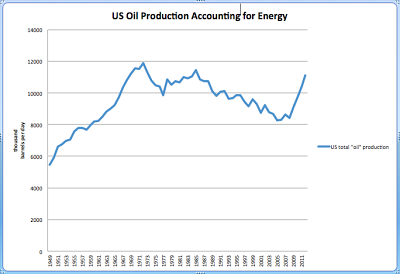
Not bad. We had a peak in 1970, but now we have quite a strong upward trend. OPEC watch out! But let’s consider that not all “oil” is equal in terms of energy. Natural gas liquids have only 70% of the energy content of oil and ethanol has only 66%. Last year NGLs were 22% of our total domestic “oil” supply and ethanol was 9%. Let’s correct our energy picture for the lower energy content of these two items. We get:
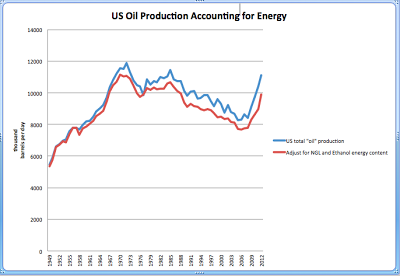
Just a little diminished, but nothing much to worry about. Still strong. Now let’s adjust for the energy it takes to refine this oil into something we can use. It takes more energy to refine oil than we get from refinery gains, so net refinery gains don’t exist in energy terms. However, refiners have been improving the efficiency of their processes, so while refining used to use up the equivalent of 10% of all the oil energy, now it uses up only 9.1%. In addition, refineries are using more purchased steam, natural gas and electricity for power rather than their own oil products. This allows more total oil products to be produced, factoring into the higher refinery “gains.” (But still not higher than refinery losses.) Interestingly, the US counts refinery gains on imported oil as domestic production, so we have to back out the energy we spend processing foreign oil as well to get a true picture of the energy leftover after refining. We get:

Now let’s consider that it takes energy to make or capture energy. Long ago oil was so easy to drill and pump, with one barrel’s worth of energy you could get 99 out of the ground. That oil had an EROEI (Energy Returned on Energy Invested) of 99. You put in 1 and got 99 back. But the one you put in is gone, lost. You have to subtract it out of the energy picture in order to determine of how much energy is left for society (all 315 million US citizens) to use.
EROEI for oil has been shrinking since the first easy oil days. In 1949, EROEI for domestic oil was 20. By 1974 it was 18. By 1982, it had sunk down to 8, but then Alaska’s North Slope oil fields arrived on the scene and our oil EROEI popped back up to 17 for most of the 90s. But lately it’s been dropping again, and now it’s back down to almost 10. This means we have to invest one barrel of oil to get 10 out. This means we have to subtract from our total energy count one barrel’s worth of energy for every ten we get out of the ground.
Now in the case of ethanol from corn, it takes roughly as much energy to grow, transport and process the corn into ethanol as the energy we get out of ethanol. So there is no net energy gain. Rather, ethanol is a complicated way to turn the diesel of farm equipment and trucking and the natural gas used to create fertilizer into equivalent energy that will run our cars. (And use up water and valuable farmland while we’re at it.)
In addition, even our reported crude oil is not all crude oil. Some of it is condensate that is lighter and has less energy--on average 91% of the energy of crude. In addition condensate cannot be used to make diesel or jet fuel. While condensate used to account for only 5% of our crude oil supply, now it is up to 14% of it. Adjusting for EROEI losses and condensate reduced energy content, we get this:
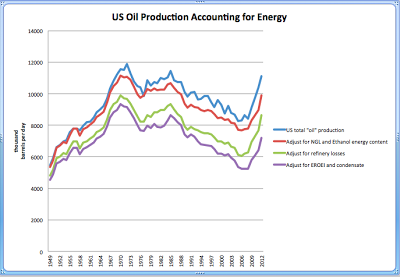
Not quite so bright a forecast. But we have a few more issues to consider. The first is that not all “oil” is used or can be turned into diesel, gasoline, or jet fuel, what we need for transportation. We used to use less of our oil for transportation—in 1949 only 61%. (Heating oil, for instance, was a popular oil product back then.) But once oil became expensive, more and more was dedicated to transportation fuels, until today 77% of our oil (this includes imports) goes to this purpose, pretty close to the refining maximum.
In addition these days more and more of our “oil” supply is coming from natural gas liquids. NGLs used to make up 8% of our domestic oil supply; now they are 22%. Only 30% of natural gas liquids can be used to make gasoline, and none of it can be used to make diesel or jet fuel.
So after we subtract out the oil that wasn’t used for transportation fuel in the past, the parts of crude oil that can’t be used for transportation fuel now, and the percentage of natural gas liquids that can’t be used for transportation fuel either, the energy available from our “oil” production for transportation looks like this:
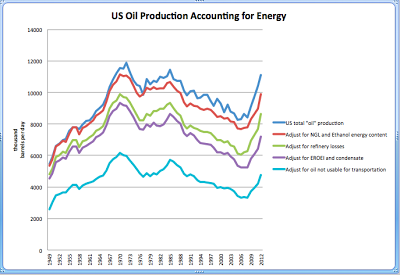
Again, the gap between the lowest line and the purple line above it is actually less than it used to be because we are dedicating more of our oil to transportation. But the overall shape of the line shows why we’re still importing so much oil. Energy-wise, we only produce domestically 42% of the oil energy we use for transportation. The rest we import. If we overlook ethanol’s lack of net energy and count it as oil energy, we still produce only 45%. If we look at a graph of this over time, it’s a pretty good downward slope with a little bump at the end.
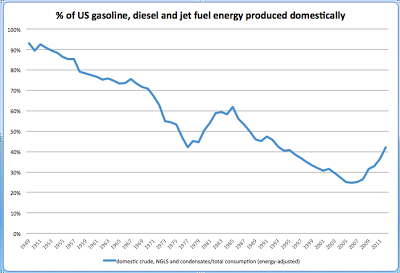
Even if we want to kid ourselves by calling lower-energy ethanol and natural gas liquids “oil,” even if we want to pretend we can count refinery gains without also counting refinery losses, even if we don’t want to recognize that every year it takes more and more energy to get the oil that’s left out of the ground, even if we ignore that ethanol transfers energy but does not provide it, even if we are unaware condensate is an increasingly higher percentage of crude oil, even if we want to believe that everything we call oil can be turned into gasoline, diesel or jet fuel, when all is said and done, reality (and net energy) prevails. It all adds up (or fails to.) The energy isn’t there. Sources: Data published by the US Energy Information Administration (1949 - 2012)
Published on March 29, 2013 11:58
March 17, 2013
Battle of the Curb
[image error]
Draw your swords in the feisty skirmish for street spacePeople who don't live in San Francisco probably won't care about this (and many who do probably won't either), but it goes to show how something apparently as trifling as parking policies on just a handful of blocks can be, in the end, rather significant in terms of land use, health and quality of life. So here goes, my letter to the SFMTA. <!-- /* Font Definitions */ @font-face {font-family:"MS 明朝"; panose-1:0 0 0 0 0 0 0 0 0 0; mso-font-charset:128; mso-generic-font-family:roman; mso-font-format:other; mso-font-pitch:fixed; mso-font-signature:1 134676480 16 0 131072 0;} @font-face {font-family:"Cambria Math"; panose-1:2 4 5 3 5 4 6 3 2 4; mso-font-charset:0; mso-generic-font-family:auto; mso-font-pitch:variable; mso-font-signature:3 0 0 0 1 0;} @font-face {font-family:Cambria; panose-1:2 4 5 3 5 4 6 3 2 4; mso-font-charset:0; mso-generic-font-family:auto; mso-font-pitch:variable; mso-font-signature:3 0 0 0 1 0;} /* Style Definitions */ p.MsoNormal, li.MsoNormal, div.MsoNormal {mso-style-unhide:no; mso-style-qformat:yes; mso-style-parent:""; margin:0in; margin-bottom:.0001pt; mso-pagination:widow-orphan; font-size:12.0pt; font-family:Cambria; mso-ascii-font-family:Cambria; mso-ascii-theme-font:minor-latin; mso-fareast-font-family:"MS 明朝"; mso-fareast-theme-font:minor-fareast; mso-hansi-font-family:Cambria; mso-hansi-theme-font:minor-latin; mso-bidi-font-family:"Times New Roman"; mso-bidi-theme-font:minor-bidi;} p.MsoListParagraph, li.MsoListParagraph, div.MsoListParagraph {mso-style-priority:34; mso-style-unhide:no; mso-style-qformat:yes; margin-top:0in; margin-right:0in; margin-bottom:0in; margin-left:.5in; margin-bottom:.0001pt; mso-add-space:auto; mso-pagination:widow-orphan; font-size:12.0pt; font-family:Cambria; mso-ascii-font-family:Cambria; mso-ascii-theme-font:minor-latin; mso-fareast-font-family:"MS 明朝"; mso-fareast-theme-font:minor-fareast; mso-hansi-font-family:Cambria; mso-hansi-theme-font:minor-latin; mso-bidi-font-family:"Times New Roman"; mso-bidi-theme-font:minor-bidi;} p.MsoListParagraphCxSpFirst, li.MsoListParagraphCxSpFirst, div.MsoListParagraphCxSpFirst {mso-style-priority:34; mso-style-unhide:no; mso-style-qformat:yes; mso-style-type:export-only; margin-top:0in; margin-right:0in; margin-bottom:0in; margin-left:.5in; margin-bottom:.0001pt; mso-add-space:auto; mso-pagination:widow-orphan; font-size:12.0pt; font-family:Cambria; mso-ascii-font-family:Cambria; mso-ascii-theme-font:minor-latin; mso-fareast-font-family:"MS 明朝"; mso-fareast-theme-font:minor-fareast; mso-hansi-font-family:Cambria; mso-hansi-theme-font:minor-latin; mso-bidi-font-family:"Times New Roman"; mso-bidi-theme-font:minor-bidi;} p.MsoListParagraphCxSpMiddle, li.MsoListParagraphCxSpMiddle, div.MsoListParagraphCxSpMiddle {mso-style-priority:34; mso-style-unhide:no; mso-style-qformat:yes; mso-style-type:export-only; margin-top:0in; margin-right:0in; margin-bottom:0in; margin-left:.5in; margin-bottom:.0001pt; mso-add-space:auto; mso-pagination:widow-orphan; font-size:12.0pt; font-family:Cambria; mso-ascii-font-family:Cambria; mso-ascii-theme-font:minor-latin; mso-fareast-font-family:"MS 明朝"; mso-fareast-theme-font:minor-fareast; mso-hansi-font-family:Cambria; mso-hansi-theme-font:minor-latin; mso-bidi-font-family:"Times New Roman"; mso-bidi-theme-font:minor-bidi;} p.MsoListParagraphCxSpLast, li.MsoListParagraphCxSpLast, div.MsoListParagraphCxSpLast {mso-style-priority:34; mso-style-unhide:no; mso-style-qformat:yes; mso-style-type:export-only; margin-top:0in; margin-right:0in; margin-bottom:0in; margin-left:.5in; margin-bottom:.0001pt; mso-add-space:auto; mso-pagination:widow-orphan; font-size:12.0pt; font-family:Cambria; mso-ascii-font-family:Cambria; mso-ascii-theme-font:minor-latin; mso-fareast-font-family:"MS 明朝"; mso-fareast-theme-font:minor-fareast; mso-hansi-font-family:Cambria; mso-hansi-theme-font:minor-latin; mso-bidi-font-family:"Times New Roman"; mso-bidi-theme-font:minor-bidi;} .MsoChpDefault {mso-style-type:export-only; mso-default-props:yes; font-family:Cambria; mso-ascii-font-family:Cambria; mso-ascii-theme-font:minor-latin; mso-fareast-font-family:"MS 明朝"; mso-fareast-theme-font:minor-fareast; mso-hansi-font-family:Cambria; mso-hansi-theme-font:minor-latin; mso-bidi-font-family:"Times New Roman"; mso-bidi-theme-font:minor-bidi;} @page WordSection1 {size:8.5in 11.0in; margin:1.0in 1.25in 1.0in 1.25in; mso-header-margin:.5in; mso-footer-margin:.5in; mso-paper-source:0;} div.WordSection1 {page:WordSection1;} /* List Definitions */ @list l0 {mso-list-id:113909258; mso-list-type:hybrid; mso-list-template-ids:-1736828536 -626607680 67698713 67698715 67698703 67698713 67698715 67698703 67698713 67698715;} @list l0:level1 {mso-level-text:"%1\)"; mso-level-tab-stop:none; mso-level-number-position:left; margin-left:1.25in; text-indent:-.25in;} @list l0:level2 {mso-level-number-format:alpha-lower; mso-level-tab-stop:none; mso-level-number-position:left; margin-left:1.75in; text-indent:-.25in;} @list l0:level3 {mso-level-number-format:roman-lower; mso-level-tab-stop:none; mso-level-number-position:right; margin-left:2.25in; text-indent:-9.0pt;} @list l0:level4 {mso-level-tab-stop:none; mso-level-number-position:left; margin-left:2.75in; text-indent:-.25in;} @list l0:level5 {mso-level-number-format:alpha-lower; mso-level-tab-stop:none; mso-level-number-position:left; margin-left:3.25in; text-indent:-.25in;} @list l0:level6 {mso-level-number-format:roman-lower; mso-level-tab-stop:none; mso-level-number-position:right; margin-left:3.75in; text-indent:-9.0pt;} @list l0:level7 {mso-level-tab-stop:none; mso-level-number-position:left; margin-left:4.25in; text-indent:-.25in;} @list l0:level8 {mso-level-number-format:alpha-lower; mso-level-tab-stop:none; mso-level-number-position:left; margin-left:4.75in; text-indent:-.25in;} @list l0:level9 {mso-level-number-format:roman-lower; mso-level-tab-stop:none; mso-level-number-position:right; margin-left:5.25in; text-indent:-9.0pt;} @list l1 {mso-list-id:799154391; mso-list-type:hybrid; mso-list-template-ids:1694117748 -654659264 67698713 67698715 67698703 67698713 67698715 67698703 67698713 67698715;} @list l1:level1 {mso-level-text:"%1\)"; mso-level-tab-stop:none; mso-level-number-position:left; margin-left:.75in; text-indent:-.25in;} @list l1:level2 {mso-level-number-format:alpha-lower; mso-level-tab-stop:none; mso-level-number-position:left; margin-left:1.25in; text-indent:-.25in;} @list l1:level3 {mso-level-number-format:roman-lower; mso-level-tab-stop:none; mso-level-number-position:right; margin-left:1.75in; text-indent:-9.0pt;} @list l1:level4 {mso-level-tab-stop:none; mso-level-number-position:left; margin-left:2.25in; text-indent:-.25in;} @list l1:level5 {mso-level-number-format:alpha-lower; mso-level-tab-stop:none; mso-level-number-position:left; margin-left:2.75in; text-indent:-.25in;} @list l1:level6 {mso-level-number-format:roman-lower; mso-level-tab-stop:none; mso-level-number-position:right; margin-left:3.25in; text-indent:-9.0pt;} @list l1:level7 {mso-level-tab-stop:none; mso-level-number-position:left; margin-left:3.75in; text-indent:-.25in;} @list l1:level8 {mso-level-number-format:alpha-lower; mso-level-tab-stop:none; mso-level-number-position:left; margin-left:4.25in; text-indent:-.25in;} @list l1:level9 {mso-level-number-format:roman-lower; mso-level-tab-stop:none; mso-level-number-position:right; margin-left:4.75in; text-indent:-9.0pt;} @list l2 {mso-list-id:1003245156; mso-list-type:hybrid; mso-list-template-ids:-280325358 67698705 67698713 67698715 67698703 67698713 67698715 67698703 67698713 67698715;} @list l2:level1 {mso-level-text:"%1\)"; mso-level-tab-stop:none; mso-level-number-position:left; text-indent:-.25in;} @list l2:level2 {mso-level-number-format:alpha-lower; mso-level-tab-stop:none; mso-level-number-position:left; text-indent:-.25in;} @list l2:level3 {mso-level-number-format:roman-lower; mso-level-tab-stop:none; mso-level-number-position:right; text-indent:-9.0pt;} @list l2:level4 {mso-level-tab-stop:none; mso-level-number-position:left; text-indent:-.25in;} @list l2:level5 {mso-level-number-format:alpha-lower; mso-level-tab-stop:none; mso-level-number-position:left; text-indent:-.25in;} @list l2:level6 {mso-level-number-format:roman-lower; mso-level-tab-stop:none; mso-level-number-position:right; text-indent:-9.0pt;} @list l2:level7 {mso-level-tab-stop:none; mso-level-number-position:left; text-indent:-.25in;} @list l2:level8 {mso-level-number-format:alpha-lower; mso-level-tab-stop:none; mso-level-number-position:left; text-indent:-.25in;} @list l2:level9 {mso-level-number-format:roman-lower; mso-level-tab-stop:none; mso-level-number-position:right; text-indent:-9.0pt;} ol {margin-bottom:0in;} ul {margin-bottom:0in;} </style><span style="font-size: small;"><span style="font-family: inherit;"> </span></span><br /><span style="font-size: small;"><span style="font-family: inherit;">Dear Folks at the San Francisco Metro Transit Authority:</span></span><br /><span style="font-size: small;"><span style="font-family: inherit;"> </span></span><br /><span style="font-size: small;"><span style="font-family: inherit;">I have lived on the northern edge of Noe Valley for 18 years. My husband and I have raised three children here. Next to Noe Valley and the Castro, the Mission is the neighborhood I frequent most as a destination (<span style="font-size: small;">s</span>hops! <span style="font-size: small;">r</span>estaurants! <span style="font-size: small;">c</span>lasses!), and it’s the neighborhood I pass through most often on my way to other destinations. In addition, having had a daughter take nearly daily dance classes at ODC for seven years, I am well acquainted with the area near the new proposed park on 17<sup>th</sup> Street. I’m also very interested in parking management policies at the SFMTA in general as it directly impacts the quality of life in San Francisco, and, by either encouraging or discouraging car use, the health and safety of all San Franciscans, including my own family’s.</span></span><br /><br /><div style="text-align: justify;"><span style="font-size: small;"><span style="font-family: inherit;"> </span></span></div><span style="font-size: small;"><span style="font-family: inherit;">In the United States motorized vehicles are a greater public health threat than guns and cigarettes combined. Every year in the US more people die from car collisions than gun violence; every year more people die from a car-induced sedentary lifestyle (via obesity<span style="font-size: small;">, </span>diabetes and heart disease) and poisoning from car exhaust (via asthma and lung cancer) than from cigarettes. When people don’t rely on cars for trips under 3 miles, it is easy for them to get the necessary 30 minutes of moderate physical activity each day that they need for basic health. People who rely on cars for all trips get almost no exercise and have terrible health as a result. Even the moderate amounts of walking associated with taking public transit have proven to increase the health of those who do it.</span></span><br /><span style="font-size: small;"><span style="font-family: inherit;"> </span></span><br /><span style="font-size: small;"><span style="font-family: inherit;"> </span></span><br /><table cellpadding="0" cellspacing="0" class="tr-caption-container" style="float: left; margin-right: 1em; text-align: left;"><tbody><tr><td style="text-align: center;"><a href="http://3.bp.blogspot.com/-bTtJ2UFOzW4..." imageanchor="1" style="clear: left; margin-bottom: 1em; margin-left: auto; margin-right: auto;"><img border="0" src="http://3.bp.blogspot.com/-bTtJ2UFOzW4..." /></a></td></tr><tr><td class="tr-caption" style="text-align: center;">Are these the only killers?</td></tr></tbody></table><div class="MsoNormal" style="text-align: justify;"><span style="font-size: small;"><span style="font-family: inherit;">But while cigarette smoking is subjected to ever more draconian regulation, cars are not only tolerated but encouraged at the expense of the taxpayer through subsidized parking, subsidized roads, subsidized gasoline, and, when they crash, subsidized emergency personnel and clean up crew time. In addition car drivers don’t pay for the external environmental damage their vehicles’ pollution inflicts, the health damage their exhaust inflicts, or the climate damage caused by their CO2 emissions. With the exception of helicopters and tanks, private cars are the least energy-efficient mode of transport and the least space-efficient.<span style="font-size: small;"> </span>Very often car drivers drive uninsured (14% in California) or drive with such low levels of insurance ($15,000) that they can’t pay for the medical costs of the bicyclists or pedestrians they hit. Even in a highly dense city like San Francisco where space is scarce and getting scarcer, we’ve made car driving the cheapest, fastest, safest, pleasantest, most direct, least effort, most convenient way to get places. Is it any wonder people choose to drive? As our city grows in population, is it any wonder there is so much conflict and friction around car storage and driving?</span></span></div><span style="font-size: small;"><span style="font-family: inherit;"> </span></span><br /><span style="font-size: small;"><span style="font-family: inherit;"> </span></span><br /><div style="text-align: right;"></div><div class="separator" style="clear: both; text-align: center;"><a href="http://1.bp.blogspot.com/-mQa62TMRHa4..." imageanchor="1" style="clear: right; float: right; margin-bottom: 1em; margin-left: 1em;"><img border="0" height="232" src="http://1.bp.blogspot.com/-mQa62TMRHa4..." width="320" /></a></div><div class="MsoNormal" style="text-align: justify;"><span style="font-size: small;"><span style="font-family: inherit;">Until four years ago I used to drive almost everywhere I went in San Francisco. Now my husband and I bike almost everywhere, and our children bike or take public transit.<span style="font-size: small;"> </span>Because we are a generally health family, this means that, based on San Francisco mortality statistics, being hit by a truck, bus or car is the way any member of my family is most likely to die over the next ten years. Particularly my children. Long term the air pollution caused by vehicle exhaust may also do us in. From a health perspective alone, you can see why it is in my best interests to reduce the traffic on San Francisco streets as much as possible.</span></span></div><span style="font-size: small;"><span style="font-family: inherit;"> </span></span><br /><span style="font-size: small;"><span style="font-family: inherit;"> </span></span><br /><table align="center" cellpadding="0" cellspacing="0" class="tr-caption-container" style="margin-left: auto; margin-right: auto; text-align: center;"><tbody><tr><td style="text-align: center;"><a href="http://1.bp.blogspot.com/-B81I2csIdfQ... of plan.jpg" imageanchor="1" style="margin-left: auto; margin-right: auto;"><img border="0" height="215" src="http://1.bp.blogspot.com/-B81I2csIdfQ... of plan.jpg" width="400" /></a></td></tr><tr><td class="tr-caption" style="text-align: center;"><span style="font-size: small;"><span style="font-family: Cambria;">More of the plan</span></span></td></tr></tbody></table><div class="MsoNormal" style="text-align: justify;"><span style="font-size: small;"><span style="font-family: inherit;">In the region under discussion, the streets I used to drive heavily on were 20<sup>th</sup> St, South Van Ness, 14<sup>th</sup>, 15<sup>th</sup>, Folsom, and Shotwell. The streets I now bike on are Harrison, Folsom (north of 17<sup>th</sup> St.), 17<sup>th</sup> Street, 14<sup>th</sup> Street and 22<sup>nd</sup>St. I often used to hunt for parking near ODC—on Shotwell, 17<sup>th</sup>, and 18<sup>th</sup> streets. I rarely used the lot at 17<sup>th</sup> and Shotwell. $2 might not be a high price for an hour of parking, but it’s quite high for 5 minutes to pick up or drop off a child at dance class.</span></span></div><span style="font-size: small;"><span style="font-family: inherit;">My observations about the Draft NE Mission Parking Proposal released in March 2013:</span></span><br /><span style="font-size: small;"><span style="font-family: inherit;"> </span></span><br /><span style="font-size: small;"><span style="font-family: inherit;"> </span></span><br /><table cellpadding="0" cellspacing="0" class="tr-caption-container" style="float: right; margin-left: 1em; text-align: right;"><tbody><tr><td style="text-align: center;"><a href="http://3.bp.blogspot.com/-lWSUIJs38fE... map.png" imageanchor="1" style="clear: right; margin-bottom: 1em; margin-left: auto; margin-right: auto;"><img border="0" height="246" src="http://3.bp.blogspot.com/-lWSUIJs38fE... map.png" width="320" /></a></td></tr><tr><td class="tr-caption" style="text-align: center;">Know your RPP</td></tr></tbody></table><div class="MsoListParagraphCxSpFirst" style="text-align: justify; text-indent: -0.25in;"><span style="font-size: small;"><span style="font-family: inherit;">1)Charging for street parking is a good thing. Charging $104 per year for a residential<span style="font-size: small;"> </span>parking permit, although better than nothing, is far too little. The city of San Francisco should be putting as much pressure as possible on the state legislature to allow the city to charge a price that makes sense depending on neighborhood density and other demands for scarce street space. San Francisco’s density is only going to increase. The SFMTA needs this pricing tool to have any hope of managing parking effectively.</span></span></div><span style="font-size: small;"><span style="font-family: inherit;"> </span></span><br /><div class="MsoListParagraphCxSpMiddle" style="text-align: justify; text-indent: -0.25in;"><span style="font-size: small;"><span style="font-family: inherit;">2)<span style="-moz-font-feature-settings: normal; -moz-font-language-override: normal; font-size-adjust: none; font-stretch: normal; font-style: normal; font-variant: normal; font-weight: normal; line-height: normal;"></span>The RPP (residential parking permit) zone is too narrow. It should extend at least to Potrero Avenue. Anyone living on the blocks between the eastern edge of this zone (Alabama) and Potrero Avenue is going to be very sorry about thirty seconds after this RPP gets put in place because anyone hoping to continue with free parking will just move their vehicles there.</span></span></div><span style="font-size: small;"><span style="font-family: inherit;"> </span></span><br /><table align="center" cellpadding="0" cellspacing="0" class="tr-caption-container" style="margin-left: auto; margin-right: auto; text-align: center;"><tbody><tr><td style="text-align: center;"><a href="http://1.bp.blogspot.com/-ZYqIOS3tSm0..." imageanchor="1" style="margin-left: auto; margin-right: auto;"><img border="0" height="246" src="http://1.bp.blogspot.com/-ZYqIOS3tSm0..." width="400" /></a></td></tr><tr><td class="tr-caption" style="text-align: center;">A new park where there used to be parking lot!</td></tr></tbody></table><div class="MsoListParagraphCxSpMiddle" style="text-indent: -0.25in;"><span style="font-size: small;"><span style="font-family: inherit;">3)<span style="-moz-font-feature-settings: normal; -moz-font-language-override: normal; font-size-adjust: none; font-stretch: normal; font-style: normal; font-variant: normal; font-weight: normal; line-height: normal;"></span>I am all for the new park on 17<sup>th</sup> St. Parks and green space are more important than car storage any day.</span></span></div><span style="font-size: small;"><span style="font-family: inherit;"> </span></span><br /><table cellpadding="0" cellspacing="0" class="tr-caption-container" style="float: left; margin-right: 1em; text-align: left;"><tbody><tr><td style="text-align: center;"><a href="http://4.bp.blogspot.com/-DP-dQLW34iw... dance jam.jpg" imageanchor="1"><img border="0" height="200" src="http://4.bp.blogspot.com/-DP-dQLW34iw... dance jam.jpg" width="132" /></a></td></tr><tr><td class="tr-caption" style="text-align: center;"><span style="font-size: small;"><span style="font-family: Cambria;">ODC teens</span></span></td></tr></tbody></table><div class="MsoListParagraphCxSpMiddle" style="text-align: justify; text-indent: -0.25in;"><span style="font-size: small;"><span style="font-family: inherit;"> 4)ODC is no doubt a pain in the neck to anyone who lives on Shotwell. ODC also is a first rate modern dance company that makes a tremendous contribution to the community via their dance classes and their children and teen programs. (Really, their dance program for teens is phenomenal.)</span></span></div><span style="font-size: small;"><span style="font-family: inherit;"> </span></span><br /><div class="MsoListParagraphCxSpMiddle" style="text-align: justify; text-indent: -0.25in;"><span style="font-size: small;"><span style="font-family: inherit;"> 5)Having spent a lot of time on Shotwell between 17<sup>th</sup> and 18<sup>th</sup>, giving the ODC Dance Commons a loading zone will be a huge improvement. If the SFMTA can get passenger pick up and drop off for St. Charles School to really be on 18<sup>th</sup> instead of Shotwell, that would also improve the situation enormously. As it is stands now, Shotwell is pretty much misery between 3:30 and 4:30, and not much fun between 5:30 and 7:30. Also, if metered parking spaces really were available at these times on Shotwell, 18<sup>th </sup> Street or 17<sup>th </sup>Street, parents might be inclined to use them rather than double-park like they do now because there is nowhere to park except the expensive, time-consuming lot.</span></span></div><span style="font-size: small;"><span style="font-family: inherit;"> </span></span><br /><div class="separator" style="clear: both; text-align: center;"><a href="http://1.bp.blogspot.com/-QnW3gHwVxVA... carsharelogo.png" imageanchor="1" style="clear: right; float: right; margin-bottom: 1em; margin-left: 1em;"><img border="0" src="http://1.bp.blogspot.com/-QnW3gHwVxVA... carsharelogo.png" /></a></div><div class="MsoListParagraphCxSpMiddle" style="text-align: justify; text-indent: -0.25in;"><span style="font-size: small;"><span style="font-family: inherit;">6)<span style="-moz-font-feature-settings: normal; -moz-font-language-override: normal; font-size-adjust: none; font-stretch: normal; font-style: normal; font-variant: normal; font-weight: normal; line-height: normal;"></span>Curiously, this NE Mission neighborhood is currently a car-sharing desert. City Carshare offers 3 cars and 1 pick up, and Zip car offers 6 cars and two vans, all of them around the edges of the neighborhood rather than in locations convenient to this population.<span style="font-size: small;"> </span>To really encourage car-sharing, this neighborhood, with its density, needs to have a car available every other block.</span></span></div><span style="font-size: small;"><span style="font-family: inherit;"> </span></span><br /><div class="MsoListParagraphCxSpMiddle" style="text-align: justify; text-indent: -0.25in;"><span style="font-size: small;"><span style="font-family: inherit;">7)<span style="-moz-font-feature-settings: normal; -moz-font-language-override: normal; font-size-adjust: none; font-stretch: normal; font-style: normal; font-variant: normal; font-weight: normal; line-height: normal;"></span>The 16<sup>th</sup> and Mission BART station should make this area a transit lover’s dream. Instead, the BART plaza itself and the area immediately surrounding are unsavory at best during the day and patently unsafe at night. If you would not want your fourteen-year-old daughter there alone just after dark, then it is not safe enough to function as a major transit destination and transfer point. If the plaza smells bad and people get harassed going to and fro, suburbanites will never take BART to, say, an ODC evening performance rather than drive. This is a crying shame. The dysfunction of the 16<sup>th</sup>and Mission plaza without a doubt induces driving and all the negative health and neighborhood implications that entails.</span></span></div><span style="font-size: small;"><span style="font-family: inherit;"> </span></span><br /><div class="MsoListParagraphCxSpMiddle" style="text-indent: -0.25in;"><span style="font-size: small;"><span style="font-family: inherit;">8)<span style="-moz-font-feature-settings: normal; -moz-font-language-override: normal; font-size-adjust: none; font-stretch: normal; font-style: normal; font-variant: normal; font-weight: normal; line-height: normal;"> </span>This area would be perfect for bike share. Really, really perfect.</span></span></div><span style="font-size: small;"><span style="font-family: inherit;"> </span></span><br /><div class="MsoListParagraphCxSpMiddle" style="text-indent: -0.25in;"><span style="font-size: small;"><span style="font-family: inherit;">9)<span style="-moz-font-feature-settings: normal; -moz-font-language-override: normal; font-size-adjust: none; font-stretch: normal; font-style: normal; font-variant: normal; font-weight: normal; line-height: normal;"> </span>There are quite a few unused curb cuts on Shotwell between 17<sup>th</sup> and 18<sup>th</sup> alone.</span></span></div><span style="font-size: small;"><span style="font-family: inherit;"> </span></span><br /><table cellpadding="0" cellspacing="0" class="tr-caption-container" style="float: right; margin-left: 1em; text-align: right;"><tbody><tr><td style="text-align: center;"><a href="http://1.bp.blogspot.com/-w6mLEIKW3hg..." imageanchor="1" style="clear: right; margin-bottom: 1em; margin-left: auto; margin-right: auto;"><img border="0" height="149" src="http://1.bp.blogspot.com/-w6mLEIKW3hg..." width="200" /></a></td></tr><tr><td class="tr-caption" style="text-align: center;">12 bikes = 1 car</td></tr></tbody></table><div style="text-align: right;"></div><div class="MsoListParagraphCxSpMiddle" style="text-indent: -0.25in;"><span style="font-size: small;"><span style="font-family: inherit;">10)<span style="-moz-font-feature-settings: normal; -moz-font-language-override: normal; font-size-adjust: none; font-stretch: normal; font-style: normal; font-variant: normal; font-weight: normal; line-height: normal;"></span>A bike corral near the ODC Commons is an excellent idea.</span></span></div><span style="font-size: small;"><span style="font-family: inherit;"> </span></span><br /><div class="MsoListParagraphCxSpMiddle" style="text-align: justify; text-indent: -0.25in;"><span style="font-size: small;"><span style="font-family: inherit;">11)<span style="-moz-font-feature-settings: normal; -moz-font-language-override: normal; font-size-adjust: none; font-stretch: normal; font-style: normal; font-variant: normal; font-weight: normal; line-height: normal;"></span>It appears that much of the planned metered areas are not for commercial customers but rather to provide parking to employees of businesses in the area. Especially the large ones such as PG&E, MUNI, UCSF and Comcast, all located, surprisingly, within three short, easy-to-walk blocks of BART. Charging these employees for parking rather than providing it for free is a good thing, though I wish it could be more than 50 cents an hour. However, even 50 cents an hour starts making a $72 monthly Muni pass cost-effective, and some employees may indeed begin to choose to walk, bike or take transit to work over driving if free parking is no longer an option. But given one of the employers is the City of San Francisco (at the Muni Barn) I would like to point out the savings that I, as a taxpayer, would receive from the SFMTA more actively discouraging its employees from driving to work. Driving a bus or a light rail train is an extremely sedentary job with all the associated health risks and accelerated health costs of a sedentary lifestyle. If MUNI drivers walk, bike or take transit to work (walking a few blocks on either end of their commute), they will be far healthier, their health care costs will be lower, and they will miss fewer days of work. This saves me money. If they drive to work, though we may think this is doing them a favor, these drivers will lead sicker and shorter lives. Last but not least, if our public transit system is not good enough or convenient enough for our public transit workers, who exactly is it good enough or convenient enough for? I would also point out that the health costs savings of not driving are also true for PG&E, whose employee health care costs I pay for through my utility rates. And UCSF, being a health care provider presumably cognizant of health care facts, should not allow any of its employees to drive to work just to set a<span style="font-size: small;"> good</span> example.</span></span></div><span style="font-size: small;"><span style="font-family: inherit;"> </span></span><br /><div class="MsoListParagraphCxSpLast" style="text-align: justify; text-indent: -0.25in;"><div style="text-align: justify;"><span style="font-size: small;"><span style="font-family: inherit;">12)This plan is mostly all stick and no carrot. Because the fewer cars parked in or driving through the area, the lower the friction all around to residents and businesses alike, one carrot the SFMTA could offer is this:<span style="font-size: small;"> </span>Anyone who lives or works in the NE Mission area and who donates their car to<span style="font-size: small;"> </span>one of <span style="font-size: small;">(to be determined)</span> San Francisco charities, gets their choice of two “premium” incentives<span style="font-size: small;">:</span><span style="font-size: small;"> </span></span></span><br /><span style="font-size: small;"><span style="font-family: inherit;"><span style="font-size: small;">a.</span>)<span style="-moz-font-feature-settings: normal; -moz-font-language-override: normal; font-size-adjust: none; font-stretch: normal; font-style: normal; font-variant: normal; font-weight: normal; line-height: normal;"> </span>The Transit Package: one free Clipper Card, 12 months of Muni A pass loaded onto card allowing unlimited travel on Muni or BART within San Francisco ($864 value), three free months of City CarShare membership, a $20 BART card, and two free Cable Car rides<span style="font-size: small;">.</span><span style="font-size: small;"> </span></span></span><br /><span style="font-size: small;"><span style="font-family: inherit;"><span style="font-size: small;">b</span>)<span style="-moz-font-feature-settings: normal; -moz-font-language-override: normal; font-size-adjust: none; font-stretch: normal; font-style: normal; font-variant: normal; font-weight: normal; line-height: normal;"> </span>The Bike Pa<span style="font-size: small;">cka</span>ge: one free Public 7 speed bike ($449 value), one year membership to the San Francisco Bike Coalition (and all attendant member discounts), three free months of City CarShare membership, a $20 BART card, and two free Cable Car rides.</span></span></div></div><div style="text-align: justify;"><br /></div><div style="text-align: justify;"><span style="font-size: small;"><span style="font-family: inherit;">This could be advertised in flyers to residents and businesses. The incentives could also be offered to congregants of St. Charles Church, the families who attend St. Charles School, and people taking classes at ODC. (It is possible the list of charities to donate to could include the St. Charles School and ODC.) The flyers should also point out that by selling their car they will avoid car-related costs on average of $4500 per year (medium sedan more than 5 years old), $7500 per year (medium sedan less than 5 years old), or $11,000 per year (SUV or van less than 5 years old.)</span></span></div><div style="text-align: justify;"><br /></div><table align="center" cellpadding="0" cellspacing="0" class="tr-caption-container" style="float: right; margin-left: 1em; text-align: right;"><tbody><tr><td style="text-align: center;"><a href="http://1.bp.blogspot.com/-LnndE_zZv1w... car.jpg" imageanchor="1" style="margin-left: auto; margin-right: auto;"><img border="0" src="http://1.bp.blogspot.com/-LnndE_zZv1w... car.jpg" /></a></td></tr><tr><td class="tr-caption" style="text-align: center;">Lost hometown treat</td></tr></tbody></table><div class="MsoNormal" style="text-align: justify;"><span style="font-size: small;"><span style="font-family: inherit;">Anyone receiving the premiums would have to deduct the value of the Muni pass or Public bike from the tax write-off of the car donation, but since most people don’t itemize their deductions and won’t claim the write-off, it won’t matter much. The actual cost to the city would be very little, assuming you could get Public Bike (or some other bike company), the SFBC, City Carshare and BART to donate in exchange for advertising their products and/or directly recruiting new users to their services. The Cable Car rides would just be a nice treat. (Do you know how many San Franciscans actually get to ride our city’s cable cars these days? <span style="font-size: small;">P</span>recious few.)</span></span><br /><span style="font-size: small;"><span style="font-family: inherit;"> </span></span> </div><div style="text-align: justify;"><span style="font-size: small;"><span style="font-family: inherit;"></span><span style="font-family: inherit;">Now, probably few in the area would take up the offer, mostly because unless their car is a junker, selling it is always going to be the better economic deal. (Unless they just don’t want the hassle of dealing with Craigslist buyers.) But even if only 10 people donated their car in exchange for the premiums, such a program would:</span><span style="font-family: inherit;"> </span></span></div><div class="MsoListParagraphCxSpFirst" style="margin-left: 0.75in; text-indent: -0.25in;"><span style="font-size: small;"><span style="font-family: inherit;"><span style="font-size: small;">a</span>)<span style="-moz-font-feature-settings: normal; -moz-font-language-override: normal; font-size-adjust: none; font-stretch: normal; font-style: normal; font-variant: normal; font-weight: normal; line-height: normal;"> </span>Be good PR. The city is not only taking but willing to give.<span style="font-size: small;"> </span></span></span><br /><br /><span style="font-size: small;"><span style="font-family: inherit;"><span style="font-size: small;">b</span>)<span style="-moz-font-feature-settings: normal; -moz-font-language-override: normal; font-size-adjust: none; font-stretch: normal; font-style: normal; font-variant: normal; font-weight: normal; line-height: normal;"> </span>Let <span style="font-size: small;">folks</span> know explicitly the cost of a Muni pass and what you get for it. Though we might assume everyone knows this already, people who drive everywhere very possibly do not.</span></span></div><span style="font-size: small;"><span style="font-family: inherit;"> </span></span><br /><div class="MsoListParagraphCxSpMiddle" style="margin-left: 0.75in; text-align: justify; text-indent: -0.25in;"><span style="font-size: small;"><span style="font-family: inherit;"><span style="font-size: small;">c</span>)<span style="-moz-font-feature-settings: normal; -moz-font-language-override: normal; font-size-adjust: none; font-stretch: normal; font-style: normal; font-variant: normal; font-weight: normal; line-height: normal;"><span style="font-size: small;"> </span></span>Put the idea in people’s head that getting rid of their car might be something they want to do.</span></span></div><span style="font-size: small;"><span style="font-family: inherit;"> </span></span><br /><div class="MsoListParagraphCxSpMiddle" style="margin-left: 0.75in; text-indent: -0.25in;"><span style="font-size: small;"><span style="font-family: inherit;"><span style="font-size: small;">d</span>)<span style="-moz-font-feature-settings: normal; -moz-font-language-override: normal; font-size-adjust: none; font-stretch: normal; font-style: normal; font-variant: normal; font-weight: normal; line-height: normal;"> </span>Put into people’s heads the idea that transit carshare is as good as a car or bike carshare is as good as a car</span></span></div><span style="font-size: small;"><span style="font-family: inherit;"> </span></span><br /><div class="MsoListParagraphCxSpMiddle" style="margin-left: 0.75in; text-indent: -0.25in;"><span style="font-size: small;"><span style="font-family: inherit;"><span style="font-size: small;">e</span>)<span style="-moz-font-feature-settings: normal; -moz-font-language-override: normal; font-size-adjust: none; font-stretch: normal; font-style: normal; font-variant: normal; font-weight: normal; line-height: normal;"> </span>It might be just enough to nudge someone on the fence into taking action.</span></span></div><span style="font-size: small;"><span style="font-family: inherit;"> </span></span><br /><div class="MsoListParagraphCxSpLast" style="margin-left: 0.75in; text-indent: -0.25in;"><div style="text-align: justify;"><span style="font-size: small;"><span style="font-family: inherit;"><span style="font-size: small;">f</span>)<span style="-moz-font-feature-settings: normal; -moz-font-language-override: normal; font-size-adjust: none; font-stretch: normal; font-style: normal; font-variant: normal; font-weight: normal; line-height: normal;"> </span>It would get those ten cars off the stree<span style="font-size: small;">t. </span></span></span></div><div style="text-align: justify;"><br /></div><div style="text-align: justify;"><span style="font-size: small;"><span style="font-family: inherit;"><span style="font-size: small;"> </span>The reason<span style="font-size: small;"> to</span> only give the package if someone donates their car (rather than sells<span style="font-size: small;"> </span>it) is that the donation process is much easier to track and control via the companies who do this for the charity non-profits. In addition, if someone donates a car, they then don’t get a pile of cash to buy a new one, making it far more likely to result in a net reduction of cars on the streets. The transit pass premium is more likely to be chosen since it’s a better economic deal than the bike, although anyone who realizes the convenience and health benefits of biking might choose the shiny new bike.</span></span></div></div><span style="font-size: small;"><span style="font-family: inherit;"> </span></span><br /><div class="MsoNormal" style="text-align: justify;"><span style="font-size: small;"><span style="font-family: inherit;"></span></span></div><span style="font-size: small;"><span style="font-family: inherit;"> </span></span><br /><span style="font-size: small;"><span style="font-family: inherit;"> </span></span><span style="font-size: small;"><span style="font-family: inherit;"> </span></span><br /><table cellpadding="0" cellspacing="0" class="tr-caption-container" style="float: right; margin-left: 1em; text-align: right;"><tbody><tr><td style="text-align: center;"><a href="http://4.bp.blogspot.com/-TMDakhGlxLk... and treat.png" imageanchor="1" style="clear: right; margin-bottom: 1em; margin-left: auto; margin-right: auto;"><img border="0" height="164" src="http://4.bp.blogspot.com/-TMDakhGlxLk... and treat.png" width="200" /></a></td></tr><tr><td class="tr-caption" style="text-align: center;">Spot of bicycle badness</td></tr></tbody></table><div class="MsoListParagraphCxSpFirst" style="text-align: justify; text-indent: -0.25in;"><span style="font-size: small;"><span style="font-family: inherit;">13)<span style="-moz-font-feature-settings: normal; -moz-font-language-override: normal; font-size-adjust: none; font-stretch: normal; font-style: normal; font-variant: normal; font-weight: normal; line-height: normal;"></span>There needs to be bicycle infrastructure in this area that is separate and protected. Most ordinary people will not attempt to bicycle on city streets until a network of separated cycle lanes are introduced. (I would say 14<sup>th</sup> Street, 15<sup>th</sup> Street, 17<sup>th</sup>Street, Folsom, and Harrison all need them.) This means currently the average person in San Francisco is denied the convenience, economic savings and health benefits that bicycling provides. Also, more intersections need daylighting via reduced parking adjacent to the intersections to increase motorist visibility of pedestrians and bicyclists. Removing parking to accommodate these needs should probably be done now, before the SFMTA gets reliant on the income from the newly installed meters. A small point: drivers coming west on 17<sup>th</sup> cannot see the bike lane where it starts back up after the intersection at Treat and are constantly clipping it, endangering cyclists. The parking spot on the northwest corner of 17<sup>th</sup> and Treat needs to be removed to provide bicyclists more room, the bike lane needs to be painted green at least right in this area to give it better visibility to motorists, and then soft hit posts (or something even more substantial) need to be installed to protect bicyclists.</span></span></div><span style="font-size: small;"><span style="font-family: inherit;"> </span></span><br /><div class="MsoListParagraphCxSpLast" style="text-align: justify; text-indent: -0.25in;"><span style="font-size: small;"><span style="font-family: inherit;">14)<span style="-moz-font-feature-settings: normal; -moz-font-language-override: normal; font-size-adjust: none; font-stretch: normal; font-style: normal; font-variant: normal; font-weight: normal; line-height: normal;"> </span>I am guessing fully 50% of the parking in this area will need to be RPP zone to make this plan work. (In current plan it’s more like 35%?) I am also guessing that a 50% RPP/50% commercial meters mix will reduce parking demand enough to mak<span style="font-size: small;">e</span> this a truly pleasant/safe bicycle and walking neighborhood. This in turn will reduce car parking demand and induced car driving, which in turn will make the neighborhood even more pleasant, on and on in a positive, self-reinforcing cycle. This will increase land and housing values, and the neighborhood will become family friendly, neighborly, healthy and serene. But then the MTA will be accused of insidious gentrification. I guess you can’t have everything.</span></span></div><div class="MsoNormal" style="margin-left: .25in;"><br /></div>
Published on March 17, 2013 22:00
March 7, 2013
Beyond Safety: Why Women Need Separated Bike Lanes More Than Men Do
<!-- /* Font Definitions */ @font-face {font-family:Times; panose-1:2 0 5 0 0 0 0 0 0 0; mso-font-charset:0; mso-generic-font-family:auto; mso-font-pitch:variable; mso-font-signature:3 0 0 0 1 0;} @font-face {font-family:"MS 明朝"; mso-font-charset:78; mso-generic-font-family:auto; mso-font-pitch:variable; mso-font-signature:1 134676480 16 0 131072 0;} @font-face {font-family:"Cambria Math"; panose-1:2 4 5 3 5 4 6 3 2 4; mso-font-charset:0; mso-generic-font-family:auto; mso-font-pitch:variable; mso-font-signature:-536870145 1107305727 0 0 415 0;} @font-face {font-family:Cambria; panose-1:2 4 5 3 5 4 6 3 2 4; mso-font-charset:0; mso-generic-font-family:auto; mso-font-pitch:variable; mso-font-signature:-536870145 1073743103 0 0 415 0;} /* Style Definitions */ p.MsoNormal, li.MsoNormal, div.MsoNormal {mso-style-unhide:no; mso-style-qformat:yes; mso-style-parent:""; margin:0in; margin-bottom:.0001pt; mso-pagination:widow-orphan; font-size:12.0pt; font-family:Cambria; mso-ascii-font-family:Cambria; mso-ascii-theme-font:minor-latin; mso-fareast-font-family:"MS 明朝"; mso-fareast-theme-font:minor-fareast; mso-hansi-font-family:Cambria; mso-hansi-theme-font:minor-latin; mso-bidi-font-family:"Times New Roman"; mso-bidi-theme-font:minor-bidi;} p {mso-style-priority:99; mso-margin-top-alt:auto; margin-right:0in; mso-margin-bottom-alt:auto; margin-left:0in; mso-pagination:widow-orphan; font-size:10.0pt; font-family:Times; mso-fareast-font-family:"MS 明朝"; mso-fareast-theme-font:minor-fareast; mso-bidi-font-family:"Times New Roman";} .MsoChpDefault {mso-style-type:export-only; mso-default-props:yes; font-family:Cambria; mso-ascii-font-family:Cambria; mso-ascii-theme-font:minor-latin; mso-fareast-font-family:"MS 明朝"; mso-fareast-theme-font:minor-fareast; mso-hansi-font-family:Cambria; mso-hansi-theme-font:minor-latin; mso-bidi-font-family:"Times New Roman"; mso-bidi-theme-font:minor-bidi;} @page WordSection1 {size:8.5in 11.0in; margin:1.0in 1.25in 1.0in 1.25in; mso-header-margin:.5in; mso-footer-margin:.5in; mso-paper-source:0;} div.WordSection1 {page:WordSection1;} </style>--> <br /><table cellpadding="0" cellspacing="0" class="tr-caption-container" style="float: left; margin-right: 1em; text-align: left;"><tbody><tr><td style="text-align: center;"><a href="http://3.bp.blogspot.com/-LlgSYbX0UD8..." imageanchor="1" style="clear: left; margin-bottom: 1em; margin-left: auto; margin-right: auto;"><img border="0" height="211" src="http://3.bp.blogspot.com/-LlgSYbX0UD8..." width="320" /></a></td></tr><tr><td class="tr-caption" style="text-align: center;">Pleasant biking in Brooklyn (photo: Jim Henderson)</td></tr></tbody></table><div style="text-align: justify;"><span style="font-size: x-small;">In the United States, a country where few people bike for transportation, one fourth of bicyclists are women. In Denmark, Germany and the Netherlands, where people <span style="font-size: x-small;">bicycle</span> 15, 20 and 30 times <span style="font-size: x-small;">more than</span> Americans<span style="font-size: x-small;"> (</span>almost always for transportation<span style="font-size: x-small;">)</span> half or more of all bicyclists are female.</span></div><br /><div style="text-align: justify;"><span style="font-size: x-small;">Why is this? Do women “perceive” safety differently than men? Is bicycling in the US much safer than women think, and if they just knew the facts they would be out there with the guys, no problem? <span style="font-size: x-small;">Or are</span> US women abnormally timid and fearful, fragile flowers that must be locked up in cars because they can’t handle any kind of exertion or risk? Or <span style="font-size: x-small;">do</span> American women have a more accurate read on safety and are wisely unwilling to spill their blood chasing an adrenaline rush like thrill-seeking men? To all these questions, I say safety is not the be all and end all of bicycling. Lack of safety <span style="font-size: x-small;">may pre<span style="font-size: x-small;">vent bicycling, but s<span style="font-size: x-small;">afety alo<span style="font-size: x-small;">ne doesn't c<span style="font-size: x-small;">ause bicycling. </span></span></span></span></span>We need to think bigger and broader.</span></div><br /><span style="font-size: x-small;"> </span><br /><table cellpadding="0" cellspacing="0" class="tr-caption-container" style="float: right; margin-left: 1em; text-align: right;"><tbody><tr><td style="text-align: center;"><a href="http://1.bp.blogspot.com/-7eSLHhTGMqQ..." imageanchor="1" style="clear: right; margin-bottom: 1em; margin-left: auto; margin-right: auto;"><img border="0" height="146" src="http://1.bp.blogspot.com/-7eSLHhTGMqQ..." width="200" /></a></td></tr><tr><td class="tr-caption" style="text-align: center;">My dream (photo: Zachary Shahan)</td></tr></tbody></table><div style="text-align: justify;"><span style="font-size: x-small;">Statistics show that physically-separated bike lanes that crisscross the lands of bicycle-friendly nations are indeed safer for bicyclists. Denmark, Germany and the Netherlands have bicycle accident rates a fourth to a tenth of ours. (Statistics also show that the more people bike, the more the bike accident rate drops. Success breeds success.) However, if we really want women to cycle as an everyday occurrence in the US, we need to look beyond perceived safety and consider just how pleasant a woman’s experience of bicycling in her community truly is. Is biking without fear of cars hitting you important? Darn tootin’! But there are significant reasons other than safety that make biking on separated lanes a happy, enjoyable experience for women.</span></div><br /><table cellpadding="0" cellspacing="0" class="tr-caption-container" style="float: left; margin-right: 1em; text-align: left;"><tbody><tr><td style="text-align: center;"><a href="http://4.bp.blogspot.com/-6sdZh8MnmVk..." imageanchor="1" style="clear: left; margin-bottom: 1em; margin-left: auto; margin-right: auto;"><img border="0" height="200" src="http://4.bp.blogspot.com/-6sdZh8MnmVk..." width="192" /></a></td></tr><tr><td class="tr-caption" style="text-align: center;"><span style="font-size: x-small;"><span style="font-family: Times;">Typical (<span style="font-size: x-small;">photo<span style="font-size: x-small;">: Streetsblog)</span></span></span></span></td></tr></tbody></table><div style="text-align: justify;"><span style="font-size: x-small;">Let’s consider you’re riding down a standard bicycle lane in the US, one that is adjacent to traffic separated only by a painted line. You’re riding on the outer half of the lane so you don’t get “doored” if a car door swings out at you. This puts your left elbow pretty much at the edge of the bike lane. And let’s pretend there aren’t three cars double-parked in your bike lane every block forcing you out into traffic multiple times a minute.</span></div><br /><span style="font-size: x-small;"> </span><br /><div style="text-align: justify;"><span style="font-size: x-small;">As you ride along in your paint-created bike lane, a 10,000 lb truck passes within 8 inches of your elbow at 35mph. It doesn't hit you, merely roars by in its loud, smelly, large way. Was that particular experience unsafe? Well, no, not exactly. After all, you're fine. Was the experience unpleasant and stressful? To this question, women are going to say yes with much more frequency than men. Is this because women are big babies, and just need to gain confidence, buck up, and they'll be fine?</span></div><br /><span style="font-size: x-small;"> </span><br /><table cellpadding="0" cellspacing="0" class="tr-caption-container" style="float: right; margin-left: 1em; text-align: right;"><tbody><tr><td style="text-align: center;"><a href="http://2.bp.blogspot.com/-LaZ8CpOMduc..." imageanchor="1" style="clear: right; margin-bottom: 1em; margin-left: auto; margin-right: auto;"><img border="0" height="150" src="http://2.bp.blogspot.com/-LaZ8CpOMduc..." width="200" /></a></td></tr><tr><td class="tr-caption" style="text-align: center;"><span style="font-size: x-small;"><span style="font-family: Times;"><span style="font-size: x-small;">A</span>t your elbow.</span></span></td></tr></tbody></table><div style="text-align: justify;"><span style="font-size: x-small;">Let's consider the sheer sensory perception differences between men and women. On average, women have better peripheral vision and men have better distance vision. When riding a bike (as opposed to driving a car) one's peripheral vision is wide-open. This means that a woman will notice the 10,000 lb truck much earlier and receive a huge negative sensory impact of its looming presence all the time it's next to her. A man might not even notice the truck until it's nearly past him. On average, it's more unpleasant and stressful for a woman to ride next to large, fast-moving objects than for a man because she perceives them sooner and more clearly. It's not timidity and it's not her imagination.</span></div><br /><span style="font-size: x-small;"> </span><br /><div style="text-align: justify;"><span style="font-size: x-small;">On average, women hear multiple audio sounds simultaneously, while men, especially if focused, can more easily tune out audio sources. (Wives, this is why your husband, engrossed in his computer, literally does not hear the child crying.) So if a man is concentrating on something, he may not hear the truck roaring from behind or only be vaguely conscious of it. On average a woman is likely to perceive the roar much earlier and, unable to tune it out, experience a much more unpleasant sensory overload. It's not timidity and it's not her imagination.</span></div><br /><span style="font-size: x-small;"> </span><br /><table cellpadding="0" cellspacing="0" class="tr-caption-container" style="float: left; margin-right: 1em; text-align: left;"><tbody><tr><td style="text-align: center;"><a href="http://1.bp.blogspot.com/-_2CH7krOiLc..." imageanchor="1" style="clear: left; margin-bottom: 1em; margin-left: auto; margin-right: auto;"><img border="0" height="125" src="http://1.bp.blogspot.com/-_2CH7krOiLc..." width="200" /></a></td></tr><tr><td class="tr-caption" style="text-align: center;">Breathe in</td></tr></tbody></table><div style="text-align: justify;"><span style="font-size: x-small;">On average, women have a better sense of smell than men. On average, the nasty, stinky exhaust fumes from trucks and cars truly are more revolting to a woman than a man. It's not timidity and it's not her imagination. (And then there’s the issue of car exhaust that, at close proximity, is worse for the lungs than secondhand smoke, though as far as I know, it’s equally bad for both men and women.)</span></div><br /><span style="font-size: x-small;"> </span><br /><div style="text-align: justify;"><span style="font-size: x-small;">There is a reason most vehicular cyclists (bicyclists who claim bike lanes are harmful and prefer to ride with traffic) are men. On average men don't see, hear or smell the traffic the way women do, so they just don't find it as physically stressful or unpleasant. This is is not, by any means, to say there is no variation in men, or that all men find traffic pleasant. But do we really expect women to put on blinders, nose plugs and earplugs to deaden their senses enough to make bicycling tolerable? </span></div><br /><span style="font-size: x-small;"> </span><br /><table cellpadding="0" cellspacing="0" class="tr-caption-container" style="float: right; margin-left: 1em; text-align: right;"><tbody><tr><td style="text-align: center;"><a href="http://2.bp.blogspot.com/-eWrmqmEx2Xw..." imageanchor="1" style="clear: right; margin-bottom: 1em; margin-left: auto; margin-right: auto;"><img border="0" height="320" src="http://2.bp.blogspot.com/-eWrmqmEx2Xw..." width="240" /></a></td></tr><tr><td class="tr-caption" style="text-align: center;"><span style="font-size: x-small;"><span style="font-family: Times;">Things to see along the way</span></span></td></tr></tbody></table><div style="text-align: justify;"><span style="font-size: x-small;">The irony is that biking away from car traffic is usually an extremely pleasant sensory experience. On a bike away from traffic, you can see the light filtering through the trees, you can smell flowers in bloom, you can watch the crescent moon rise in the late afternoon sky. You can hear and see birds, you can smile at a child holding her mother’s hand as she toddles down the sidewalk, you can notice the new annuals a neighbor planted in his yard. And you can experience all of this while getting your very necessary 30 minutes of moderate exercise a day in an easy joyful way. (If you live up a hill, you can still do this very pleasantly with an electric-assist bike.)</span></div><br /><span style="font-size: x-small;"> </span><br /><div style="text-align: justify;"><span style="font-size: x-small;">Because of the significant health benefits, because of the far less damage to the environment, because of the far lower costs of accidents, road repair, and other infrastructure, every person who walks or bikes instead of taking a car saves taxpayers money. (The city of Copenhagen reckons bicyclists save the city 42 cents per mile biked.)</span></div><div style="text-align: justify;"><br /></div><div style="text-align: justify;"><span style="font-size: x-small;"> </span></div><div style="text-align: justify;"><span style="font-size: x-small;">Statistics show the more people drive in cars, the more obese they are. Studies show walking or biking 30 minutes a day prevents diabetes, heart disease and many forms of cancer. And it improves cognitive function as well as reduces brain atrophy, mental decline and risk of Alzheimer’s. Studies show the fitter you are in your fifties, the more years of good health you’ll have between the ages of 65 and 85. Children who walk or bike to school are able to concentrate better and have higher test scores than those who are driven. </span></div><br /><span style="font-size: x-small;"> </span><br /><div class="separator" style="clear: both; text-align: center;"><a href="http://4.bp.blogspot.com/-c0ciVHj3uT8..." imageanchor="1" style="clear: left; float: left; margin-bottom: 1em; margin-right: 1em;"><img border="0" height="320" src="http://4.bp.blogspot.com/-c0ciVHj3uT8..." width="284" /></a></div><div style="text-align: justify;"><span style="font-size: x-small;">There’s more. Children exposed to high levels of car exhaust score more poorly on intelligence tests and are more prone to depression, anxiety and attention problems than children who grow up in cleaner air. Children born to mothers living near a major road or freeway are twice as likely to have autism. And it turns out the exhaust from leaded gasoline from the 40s, 50s, 60s and 70s very likely <a href="http://www.motherjones.com/environmen..." target="_blank">created the violent crime wave in US cities</a> of the 60s, 70s, 80s and 90s. (My gosh, with China’s air pollution levels, in fifteen years that country is goin<span style="font-size: x-small;">g</span> up in flames.)</span></div><br /><span style="font-size: x-small;"> </span><br /><div style="text-align: justify;"><span style="font-size: x-small;">The US spends far more money on health care than any other nation on the planet and gets worse results than countries that spend half as much. Imported oil is a third of our trade deficit. Countries with high rates of walking and bicycling use half as much oil per person as we do. Driving or being driven everywhere is quite literally killing and bankrupting us. Short term it’s making us sick, stupid, and poor.</span></div><br /><span style="font-size: x-small;"> </span><br /><table cellpadding="0" cellspacing="0" class="tr-caption-container" style="float: right; margin-left: 1em; text-align: right;"><tbody><tr><td style="text-align: center;"><a href="http://1.bp.blogspot.com/-iTv4Ain-Ils..." imageanchor="1" style="clear: right; margin-bottom: 1em; margin-left: auto; margin-right: auto;"><img border="0" height="127" src="http://1.bp.blogspot.com/-iTv4Ain-Ils..." width="200" /></a></td></tr><tr><td class="tr-caption" style="text-align: center;">School transport</td></tr></tbody></table><div style="text-align: justify;"><span style="font-size: x-small;">Why do we treat bicycles as slow cars and make them duke it out in noisy, smelly traffic? Why do we design our communities to make driving as convenient, pleasant and cheap as possible while making biking and walking miserable? Shouldn’t it be the reverse, shouldn’t the cheapest, healthiest, most non-destructive forms of transport be encouraged? Shouldn’t it always be easier to walk 10 minutes to the store than drive the same half mile? Shouldn’t it be easier and completely safe for a child to bike 10 minutes to school than their parents drive them (for fear another parent in a car will smush them?)</span></div><br /><span style="font-size: x-small;"> </span><br /><div style="text-align: justify;"><span style="font-size: x-small;">A quarter of all trips Americans currently take are one mile or less. Half of all trips are under three miles. Americans currently drive 70% of all trips under a mile and 90% of trips one to three miles. It takes 20 minutes to walk a mile and less than 20 minutes to bike three miles. Again, the human body needs 30 minutes of moderate exercise a day to be healthy. Not uber-fit. Just healthy.</span></div><div style="text-align: justify;"><br /></div><div style="text-align: justify;"><span style="font-size: x-small;">Now I acknowledge that <span style="font-size: x-small;">a pleasant biking experience isn't everything--</span>convenience and connectivity of bike lanes are also im<span style="font-size: x-small;">portant. (Perhaps a future post.) But <span style="font-size: x-small;">safety alone is definitely not enough.</span></span> </span></div><br /><span style="font-size: x-small;"> </span><br /><table cellpadding="0" cellspacing="0" class="tr-caption-container" style="float: left; margin-right: 1em; text-align: left;"><tbody><tr><td style="text-align: center;"><a href="http://4.bp.blogspot.com/-MTWbWE7uguQ..." imageanchor="1" style="clear: left; margin-bottom: 1em; margin-left: auto; margin-right: auto;"><img border="0" height="133" src="http://4.bp.blogspot.com/-MTWbWE7uguQ..." width="200" /></a></td></tr><tr><td class="tr-caption" style="text-align: center;">To weep for (Copenhagenize.com)</td></tr></tbody></table><div style="text-align: justify;"><span style="font-size: x-small;">Let pedestrians have the sidewalk. Let bicycles have a protected lane separate from traffic stress-free and s<span style="font-size: x-small;">ecure</span> enough for an eight<span style="font-size: x-small;">-</span>year<span style="font-size: x-small;">-</span>old to ride in. And let cars and trucks have their travel space where they won’t do pedestrians and bicyclists harm. Populations that walk and bike in large numbers are healthy. If we want Americans to bike in large numbers, we have to make biking pleasant and enjoyable to both women and men. For the benefit of all.</span></div>
Published on March 07, 2013 18:38
March 4, 2013
The Pain in the UK, France, Italy and Spain
We live in the century of energy. Though we we may not realize it, how we use energy, the sources we derive it from, and who controls these sources are already defining our politics, our wars, our economies, and our very standard of living. To comprehend the shifting fortunes of the energy landscape that even now determine how we get to the grocery store and how we heat our homes, it’s interesting to examine the per capita oil consumption of countries around the world. Last October I reported that Per Capita Oil Consumption is Dropping Like a Rock (In Some Countries). Let’s wade into these murky waters once again to see what the last release of International Energy Agency data can tell us.
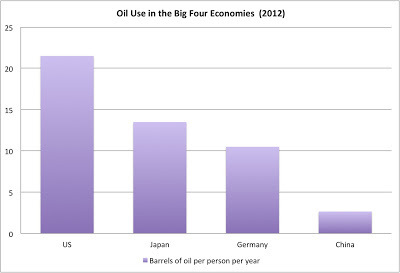 Let’s first look at the United States compared to the other economic powerhouses—China, Japan and Germany. In 2012, the US used 21.5 barrels of oil per person per year. (Let call this measure BOOPPPY.) We’ve dropped! In 2007, we used 25 BOOPPPY. However, of each person’s 21.5 BOOPPPY we imported 10.3 from the world oil market. (The money we paid for this oil is subtracted from our nation's GDP.)
Let’s first look at the United States compared to the other economic powerhouses—China, Japan and Germany. In 2012, the US used 21.5 barrels of oil per person per year. (Let call this measure BOOPPPY.) We’ve dropped! In 2007, we used 25 BOOPPPY. However, of each person’s 21.5 BOOPPPY we imported 10.3 from the world oil market. (The money we paid for this oil is subtracted from our nation's GDP.) Now although the US is becoming more efficient with its BOOPPPY, other countries are way ahead of us on this score. Germany only used 10.5 BOOPPPY, while Japan used 13.5. China, whose economic output has been soaring the past decade, consumed only 2.65 BOOPPPY! This is likely because the US uses 70% of the oil it consumes for transportation, one of the least productive economic uses we can put it to (since internal combustion engines waste most of oil’s energy as heat.) Germany uses only 50% of its oil for transportation, Japan 45% (probably less now, because since the tsunami they are using more oil for electricity production), and China 40%.
But even though China’s BOOPPPY is rising slowly every year, even though per person oil use in the US and Germany is falling, and even though Japan’s BOOPPPY has popped up due to shutting down their nuclear power plants, on the whole the big four aren’t nearly as interesting as what’s happening in parts of Europe. This where our drama lies.
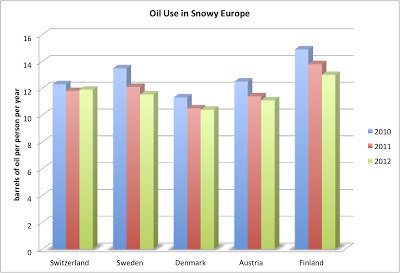 However, before the theatrics, let’s examine the stable, snowy, no drama countries—Switzerland, Sweden, Denmark, Austria and Finland. These wealthy countries all use close to half the oil per person as the US. In the past few years they’ve moderately dropped their use, Finland the most aggressively. (Of course Finland was the highest to start with.) Their gradual reduction in oil use is mostly likely to due increases in efficiency and public transportation--signs of societal investment. As such, falling oil consumption can be read as an indication of strength.
However, before the theatrics, let’s examine the stable, snowy, no drama countries—Switzerland, Sweden, Denmark, Austria and Finland. These wealthy countries all use close to half the oil per person as the US. In the past few years they’ve moderately dropped their use, Finland the most aggressively. (Of course Finland was the highest to start with.) Their gradual reduction in oil use is mostly likely to due increases in efficiency and public transportation--signs of societal investment. As such, falling oil consumption can be read as an indication of strength.
Now let’s look at the UK, France, Italy and Spain. Wow. These are advanced, complex economies that along with Germany make up the core of the EU. Remember, at this stage in the world’s energy evolution, it is no easy feat to run an advanced economy with less than 10 BOOPPPY, and yet these countries have plunged well below. Oil use that in 2010 was already frugal, even by European standards, has become positively parsimonious. The IEA data I’ve derived BOOPPPY from are yearly averages, which, by their very nature, change slowly and smooth out seasonal variation. But for this graph I’ve included numbers from the month of December 2012 to give us an indication of the direction oil use might be taking. It tells us a pretty amazing story: UK—8.3, France 9.2, Italy 7.6, and Spain 9.3.
For comparison’s sake, Mexico’s number is currently 6.7.Brazil is running around 6. Think about it: Italy is now using close to one third of the oil per person as the US. And Italy is a country where people love their cars and have lots of them. In 2001 their BOOPPPY was 13.6.
While I would like to think the drop in oil use in the UK, France, Italy and Spain is due to recent social investment in public transit and efficiency, I suspect it’s more likely due to substantial economic pain. Significantly, the less oil each country imports (without reducing their economic productivity), the better their balance of payments, and the better their financial straits become. Because these countries have had trains and transit for decades, now, when their economies are sputtering, their populations are able to forgo oil, allowing money to be spent on other things. I don't think it's an easy transition, but because of previous investment, at least it's a possible one.
(One thing I do wonder about though. If oil use in the UK oil is falling drastically--and their VMT is dropping in corresponding amounts--why were they just about the only country in EU last year with higher new car sales? How can they afford it? Are they buying new cars to sit idle in their driveways?)
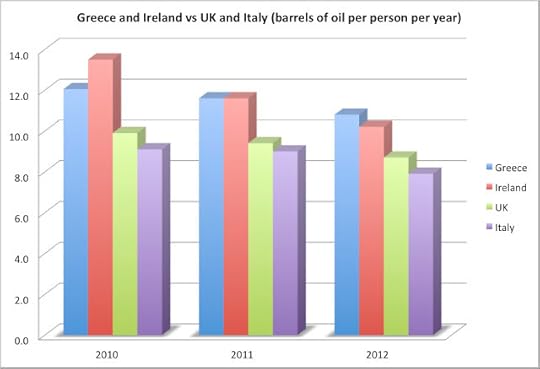
There are some other economies in dire financial straits that are curiously still spending lots of money on oil per person. Let’s look at Greece and Ireland. Both countries import all their oil. Both have economies that are flailing. For Greece, at least, the US media tells story after story of extreme economic hardship. But three years ago the BOOPPPY numbers of Greece and Ireland were higher than the four wealthier countries we just looked at, and while they’ve fallen, they’re still higher. Right now they’re consuming oil per person at the levels of Denmark and Germany. Is Greece a wealthier country than Italy? Is Ireland a wealthier country than the UK? Why haven’t the economies of Ireland and Greece responded to economic pain by reducing oil use below that of their wealthier neighbors? Is their inability to reduce their oil use to UK and Italian levels making their plight even worse?
Some final questions: how long can the US continue to use oil at a per person rate double, triple and even quintuple that of just about everyone else on the planet, including our strongest economic competitors? If the price of oil on the world market climbs, who is hurt more, countries with high BOOPPPY or low? If (or as) our economy sputters, do we become more competitive by maintaining or by reducing our rate of oil consumption?
One thing is obvious: if consumption in the EU weren’t falling like a rock, world oil prices and the price we pay for gasoline would be a great deal higher.
Published on March 04, 2013 12:15













